-
Posts
6,486 -
Joined
-
Last visited
-
Days Won
9
Content Type
Profiles
Forums
Blogs
Gallery
Events
Store
Posts posted by Brian Wolfe
-
-
The Battle of Ganadamak 1842
Perhaps it is my past as a numismatist that occasionally finds me purchasing an item because the date on the piece corresponds with the date of some famous or infamous event. The item must, of course, also bear some relevance to the event and not simply reflect a corresponding date. One such item was a British black powder percussion pistol dated 1842, which is the date of the Battle of Gandamak, Afghanistan.
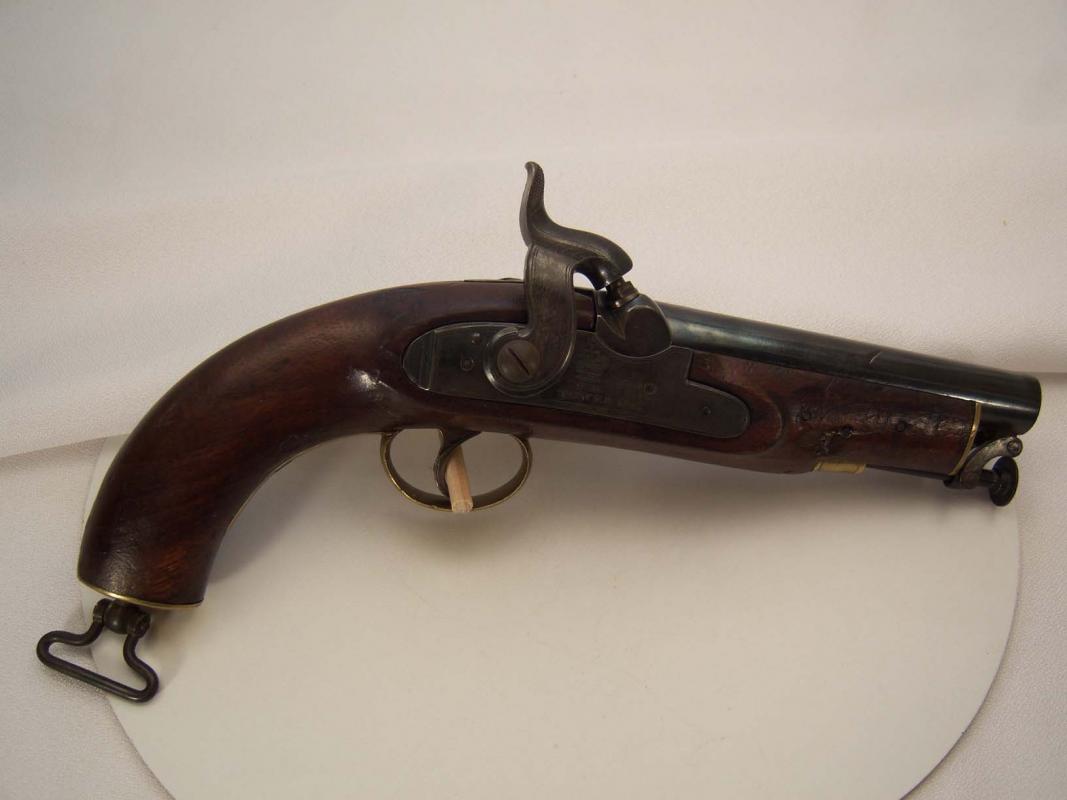
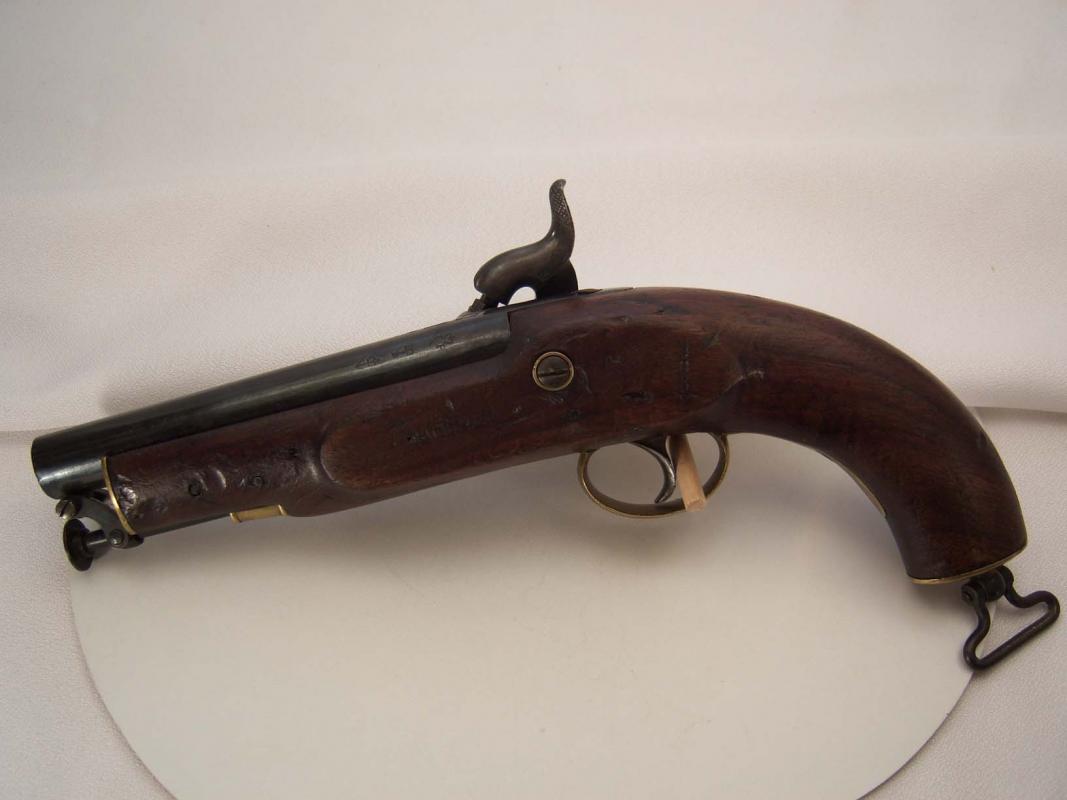
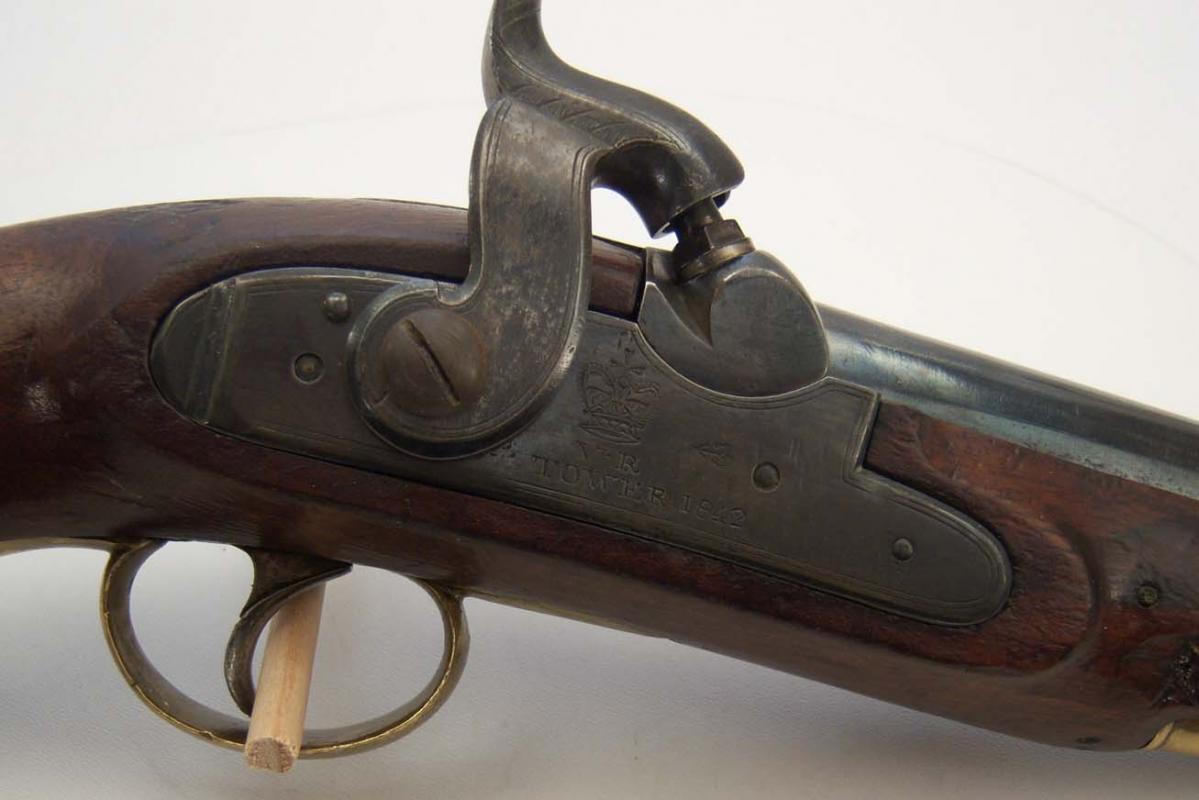
Background:
The “Grim”, as the British soldiers called it, was an inhospitable rugged piece of the world quite unsuited for empire building and the “civilizing” of the indigenous people. Civilizing, pacifying or dominating the terms all become quite subjective depending upon one’s point of view. The one indisputable point was that to be taken alive as a prisoner by a tribe such as the ruthless Pathans would result in a long and most terrible death. Of this horrible fate Rudyard Kipling once wrote:
“When you are wounded and left on Afghanistan’s plains,
An’ the women come out to cut up what remains,
Jest roll to your rifle and blow out your brains,
An’ go to your Gawd like a soldier.”
This area, the “Grim” once belonged to Afghanistan but is better known by its more official name as The North-West Frontier, of India. The North-West Frontier included names as Chitral, Waziristan, Baluchistan and Khyber perhaps the most well know for the Khyber Pass. This stretch of land between India and Afghanistan contained some of the most fearsome advisories the British Empire would ever encounter; such tribes as the Afridis, Baluchis, Chitralis, Pathans (mentioned earlier) and the Waziris. These same peoples remained as tough, resourceful and ruthless right up to the present day, facing armies from the Soviet Union then, America, Canada and other allied nations of peace keepers. However this is not about current history but that of the situation Britain found herself in during the early 1800’s.
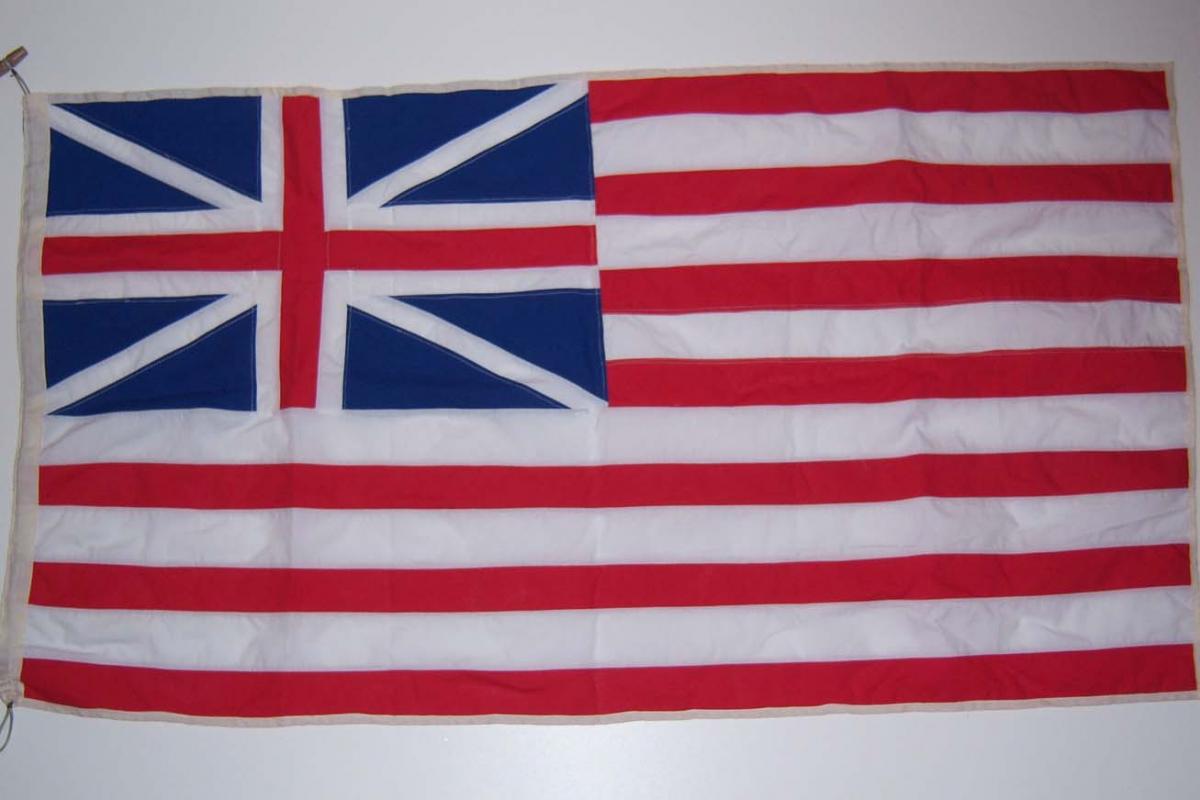
The flag of the Honourable East India Company
The First Afghan War:
Russia viewed the riches of India, British India, with envious eyes and the only way to India and her riches was through Afghanistan. Russian influence in the area had already caused upheaval in Persia and the British, as a counter move, increased their presence in the North-West Frontier and offered what amounted to bribes to the ruler of Afghanistan to resist Russian advances. Once this had taken place and the Russian threat no longer looming there was a decision made to remove the current ruler of Afghanistan and re-install the older former ruler. This accomplished, an army set out for Kabul leaving a garrison in Kandahar and once in Kabul all appeared to have calmed down to an atmosphere of peace and tranquility ; but appearances were seldom a reflection of reality in Afghanistan or along the North-West Frontier.
The 1842 Kabul Retreat or The Massacre of Elphinstone’s Army:
In the spring of 1841 the commander of the forces in Kabul retired to be replaced with the unfortunate Maj. Gen. William Elphinstone; a man suffering from ill health and lacking the ability to make sound, if any, choices regarding major decisions. I use the term “unfortunate” as at this same time the Honourable East India Company decided to cut back on the payments to the different tribal leaders resulting in attacks on caravans attempting to use the passes controlled by their tribes. Kabul was now isolated, cut off from the rest of the Empire and in effect surrounded by the enemy.
It was not long before the isolated Kabul was to see repeated attacks from the tribesmen surrounding city with sections being overrun. As the tribesmen closed in on the garrison William Henry Macnaghten, the chief advisor to Lord Auckland, now with the garrison in Kabul, attempted to negotiate with the tribesmen but was murdered along with an officer; another two were imprisoned. It was now up to Maj. Gen. Elphinstone to make the decision to surrender the city or stand and fight to the last man. The Afghans offered to allow the garrison and all personnel to march out of Kabul and return to Jalalabad, the nearest British stronghold. The offer was made with the assurances that the column would be granted safe passage. Elphinstone accepted the Afghan assurances. History would record this as one of the last poor decisions of Elphinstone’s career and the worst massacre to befall the British Army. No sooner had the column lest the safety of the city than tribesmen started sporadic attacks, picking off stragglers and laying down a harassing rifle fire killing soldiers, servants, women and children. As the column plodded along the enemy snipers and the harsh frigid weather continued to take its toll, men women and children froze to death in their tracks with many sepoys abandoning their weapons further their vulnerability. Elphinstone and a few others had been taken prisoner. In an attempted break through the Afghans lines two groups mounted despite attacks. A dozen men of the first group had ridden on toward Futtehabad with only one, the company Surgeon, Dr. William Brydon completing the trek to Jalalabad; only one of 4,500 men of Elphinstone’s command. The second group headed toward Ganamak.
The Battle of Gandamak:
On 13 January 1842 approximately fifty men led by Capt. Souter of the 44th (East Essex) Regiment of Foot reached the village of Gandamak. Earlier the 1st Brigade had left a force of Afghan irregulars at Gandamak while the main body move to Jalalabad with the hope of being able to relieve the besieged Kabul. Up to this point the local tribesmen had shown loyalty towards the British, however, as soon as the main column moved out the Afghan irregulars killed their officers, blew up the magazine and set fire to the camp. One can only imagine the disappointment felt by Capt. Souter’s men as they found a potentially hostile force in place of friendly troops waiting for them; the Afghans, under the guise of being friendly, attempted to disarm the British troops and take them prisoner. To the offer from the Afghans to spare their lives a British sergeant shouted “not bloody likely” which led to the brief but savage Battle of Gandamak. With only twenty muskets and fifty rounds of ammunition this small band stood their ground fighting hand to hand completely surrounded by the enemy. The Afghans began the attack with sniping fire followed by a series of rushes until only Souter and few soldiers and two civilians survived and were taken prisoner. In an effort to save the regimental colours Souter had wrapped them around his waist during the struggle. This appeared to be a gold sash which the Afghans mistook as the rank of a general in the British Army, thereby; it has been speculated, sparing his life and those immediately around him.
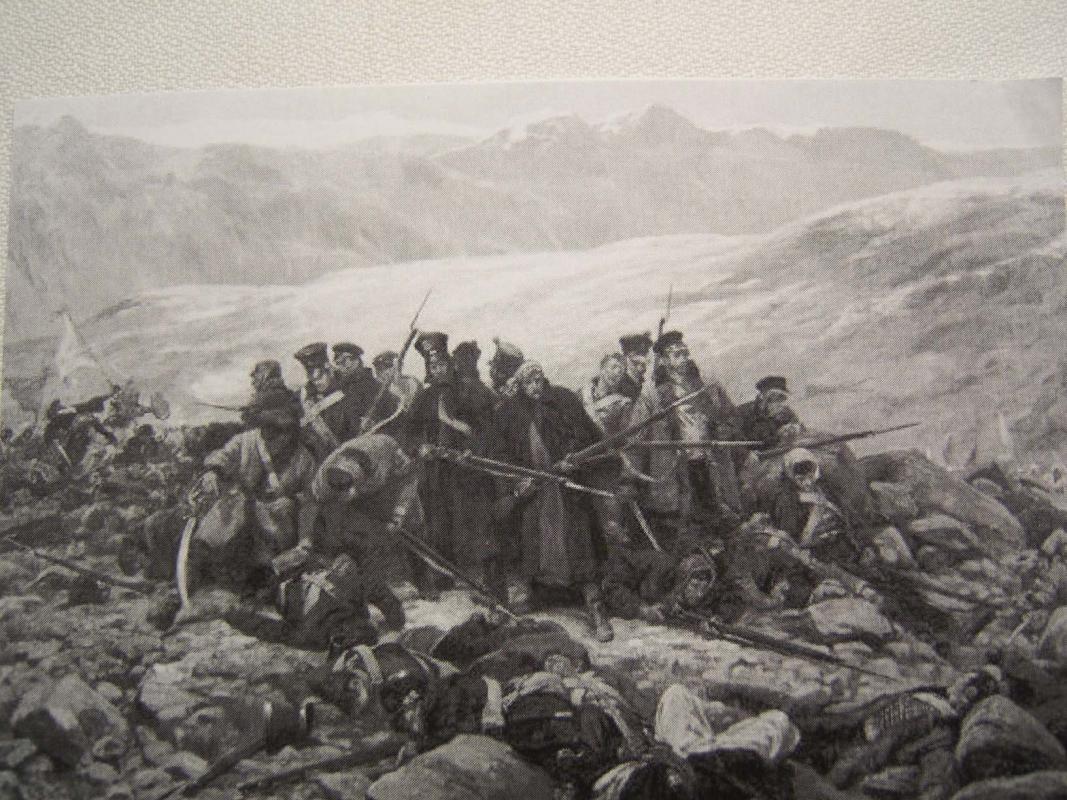
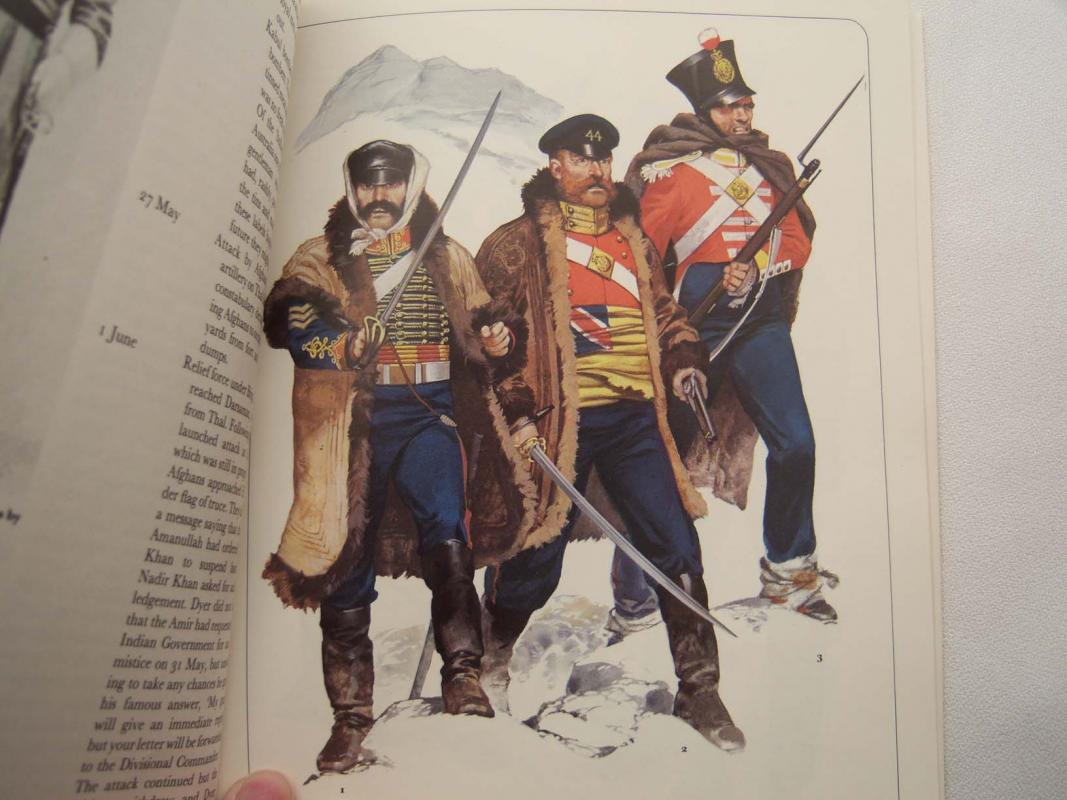
In the end Elphinstone had lost 4,500 with a total loss of 16,500 including camp followers. Sir John Kaye wrote in 1851 of the massacre: “There is nothing, indeed, more remarkable in the history of the world than the awful completeness – the sublime unity- of this Kabul tragedy.”
This episode led to the assembly of a British force at Peshawar and for the next thirty years the frontier remained unsettled with punitive expeditions political intrigues between the British and the Indian rulers all under the foreboding atmosphere of potential Russian expansionism. As one conflict ended the road to the Second Afghan War was being constructed; but that, as they say, is another story.
Regards
Brian
Sources of research for this article includes:
North-West Frontier 1837 – 1947
Robert Wilkinson-Latham
Various Wikipedia sites on the First Afghan War and the Battle of Gandamak
Arrogant Armies – Great Military Disasters and the Generals Behind Then James M. Perry
0 -
Many thanks for your supportive comments, it is most appreciated.
Regards
Brian
0 -
Thanks Nick,
I fear that the sake cup bug has bitten me a while back and this group was just too good to pass up even if my dear wife will now get the post war urushi. On the other hand it worked out well as we are both happy. The tray in the earlier post was the first one I have added to the collection so that too was a plus.
Thank you for your assistance.
Regards
Brian
0 -
Hi Rich,
I was thinking that these larger items were probably post war but I had never seen any before and the total price made them attractive.
Speaking of attractive, my wife said that she would like them if they were not going to the collection so a rare case of win, win for me.
Once more, thank you for you help.
Regards
Brian
0 -
Thank you once again for your assistance, it is greatly appreciated.
Regards
Brian
0 -
Thanks Rich.
I usually only purchase Japanese items from knowledgable sources but the price, even for the tray and this cup (which was what I was interested in), was so good I couldn't pass it up.
Tanks again,
Brian
0 -
Thanks Rich, I would be lost without your kind assistance.
Regards
Brian
0 -
Hello everyone,
This is the last piece of the grouping from the weekend. that I need help with..I promise. The bowl measures 4 3/4 inches in diameter and the sake cup/cover measures a little over 4 1/4 inches in diameter. The sake cup has some very nice decoration and the thing that caught my eye is how the artist used extra thick paint and embedded a piece of abalone shell in it. The bowl has three lines of kanji and I am hoping that this will lead to discovering the age of the set.
Other than what the writing on the bowl's bottom will reveal there is nothing telling me that this is or is not from the WWII era. The seller thought it was made in the mid 1950s. What are your opinions?
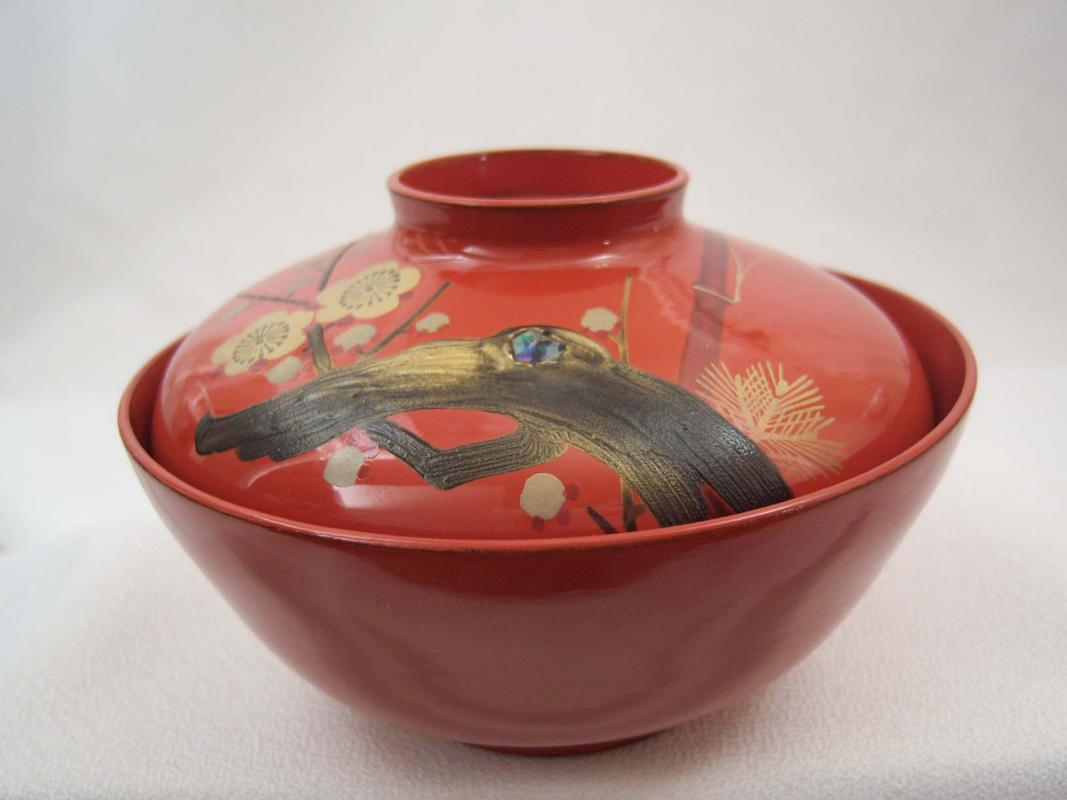
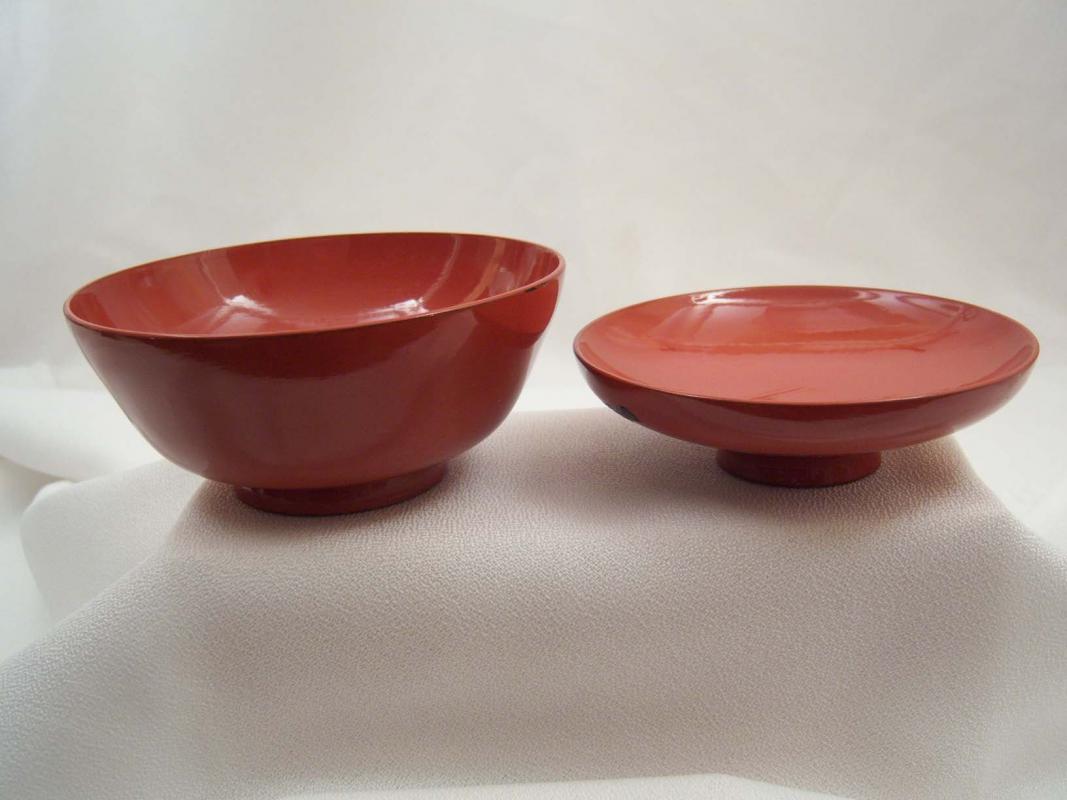
These next two photos shows the bottom of the sake cup.

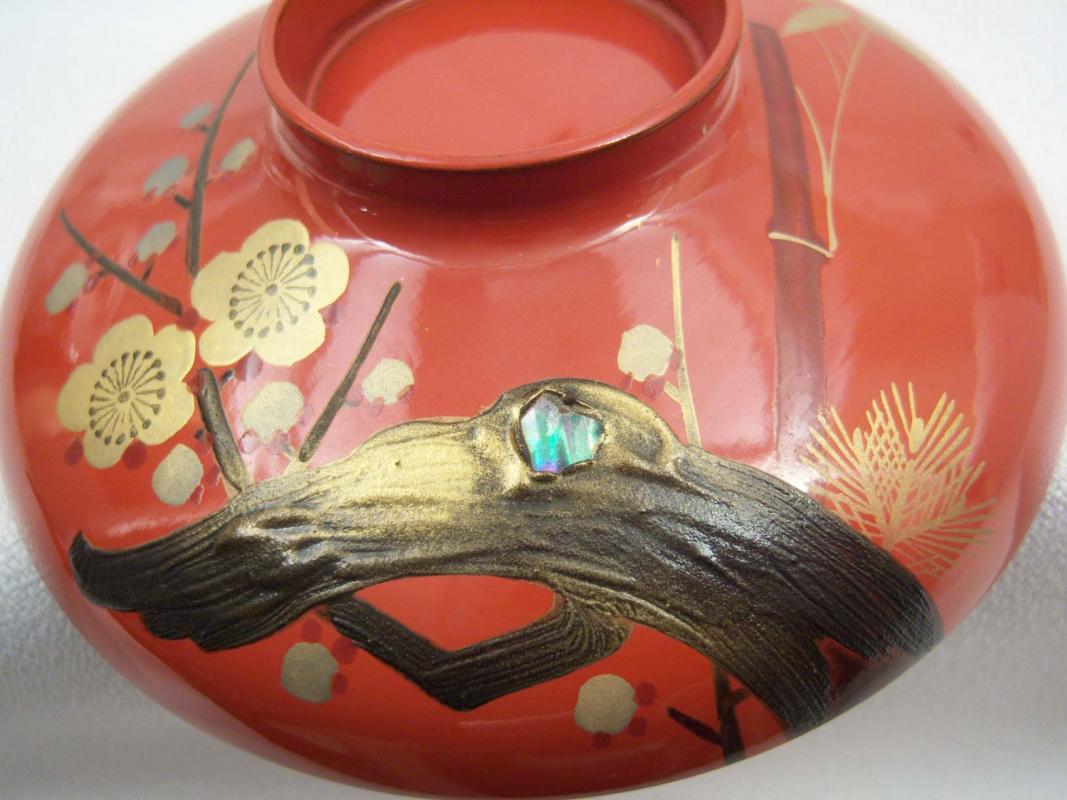
This last photo shows the writing on the bottom of the bowl. This, I am hoping, will tell us more about the cup and bowl set.
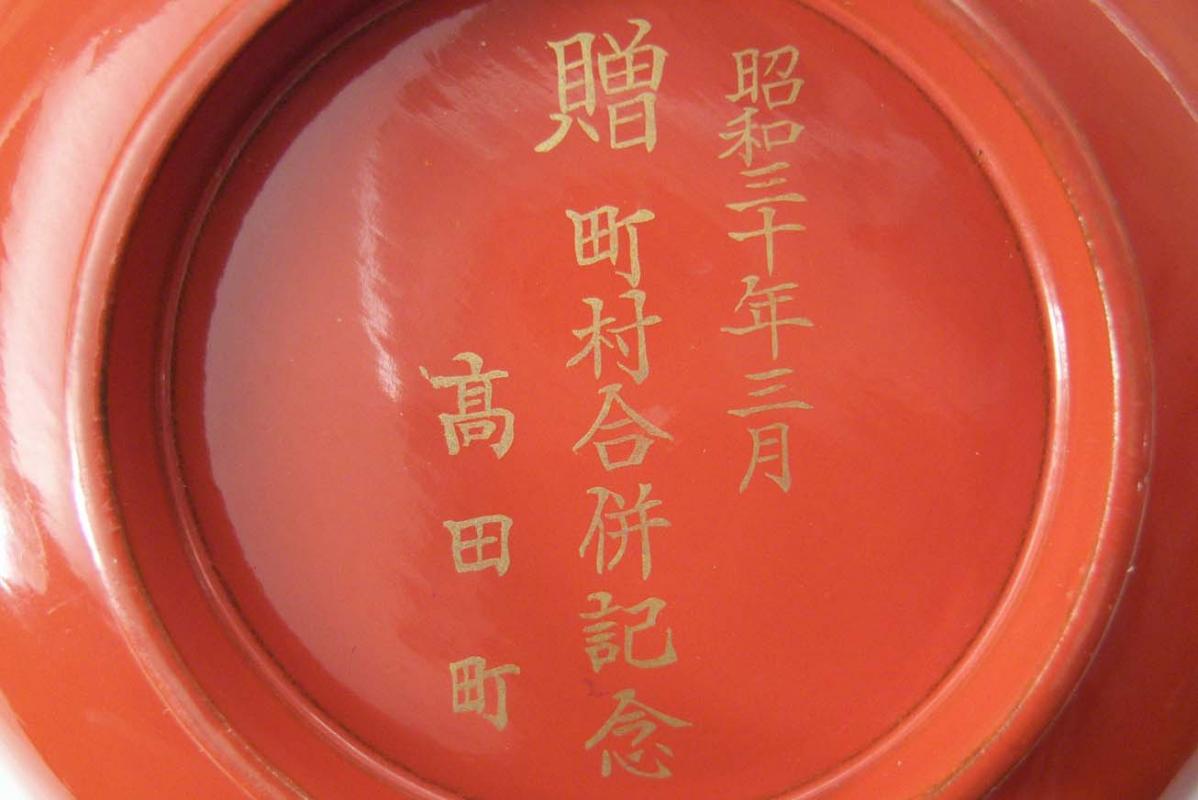
Thank you to everyone for taking the time to assist me.
I really like the collecting of Japanese artifacts but when it comes to the translations I am completely lost.
Regards
Brian
0 -
Hello EVerone,
Here is a 5 inch bowl and 4 3/4 inch sake cup cover that I would like your opinions on. There are no markings on the cup or bowl but the sake cup features a t'suba and other guard parts of a katana. This would lead me to think along the lines of a martial theme. Do you think this would have been made during the war years. The dealer had a tag that he made stating it was from the WWI or WWII period. I would think if it were from either period it would be the Second World War and not the first. What do you think?
Regards
Brian
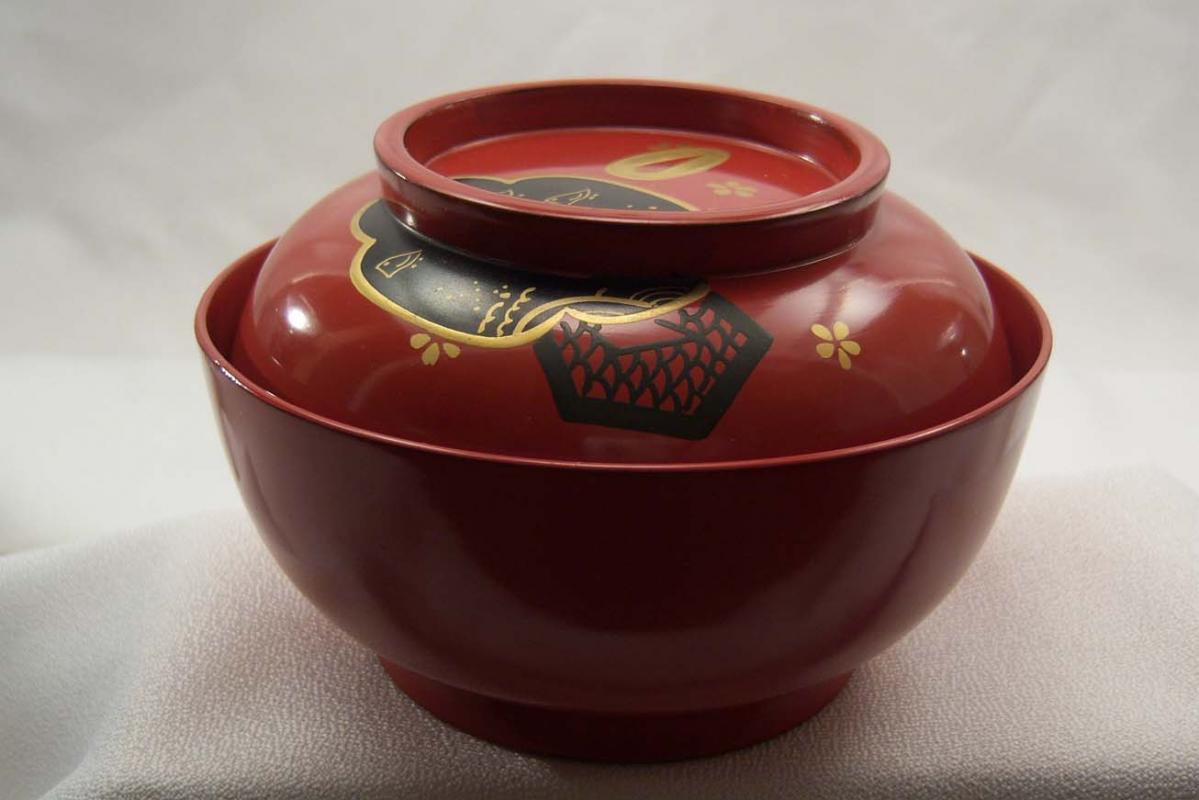
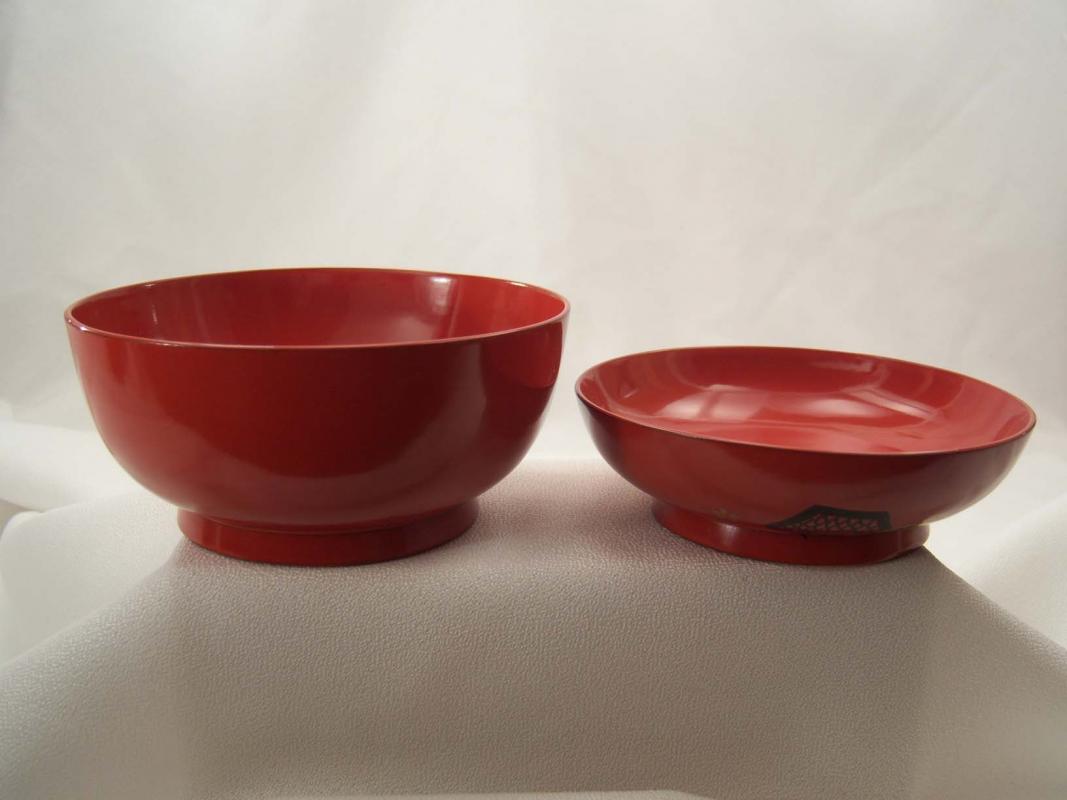
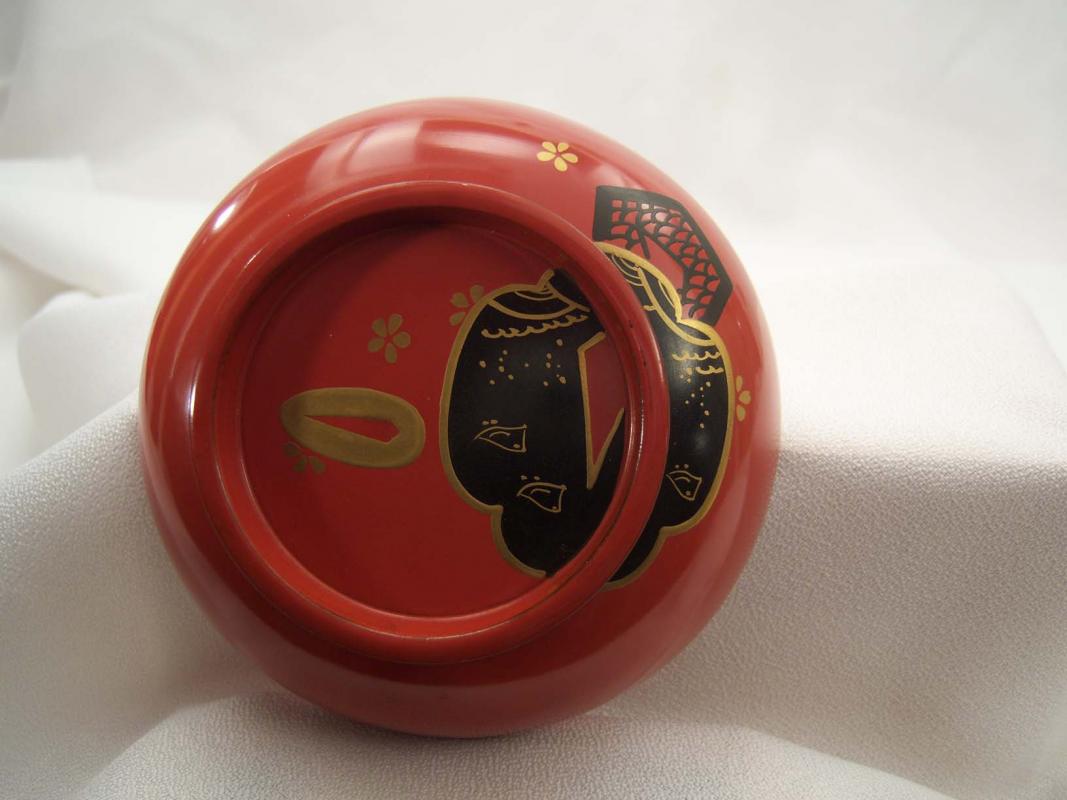 0
0 -
It looks like I made an error in posting those last three images so I will try again here.
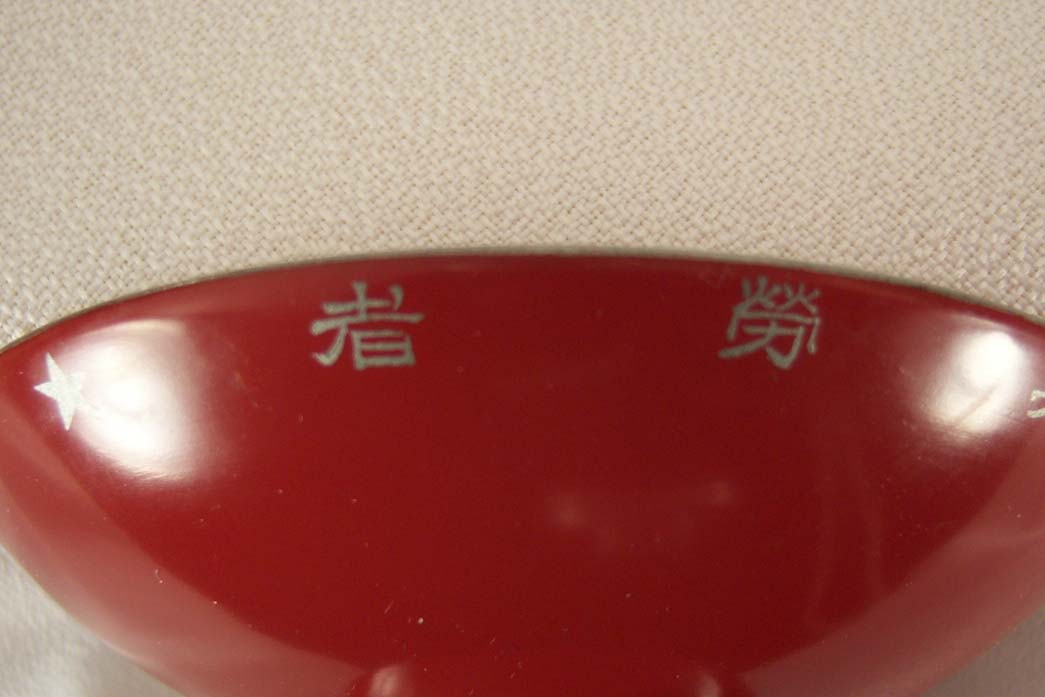
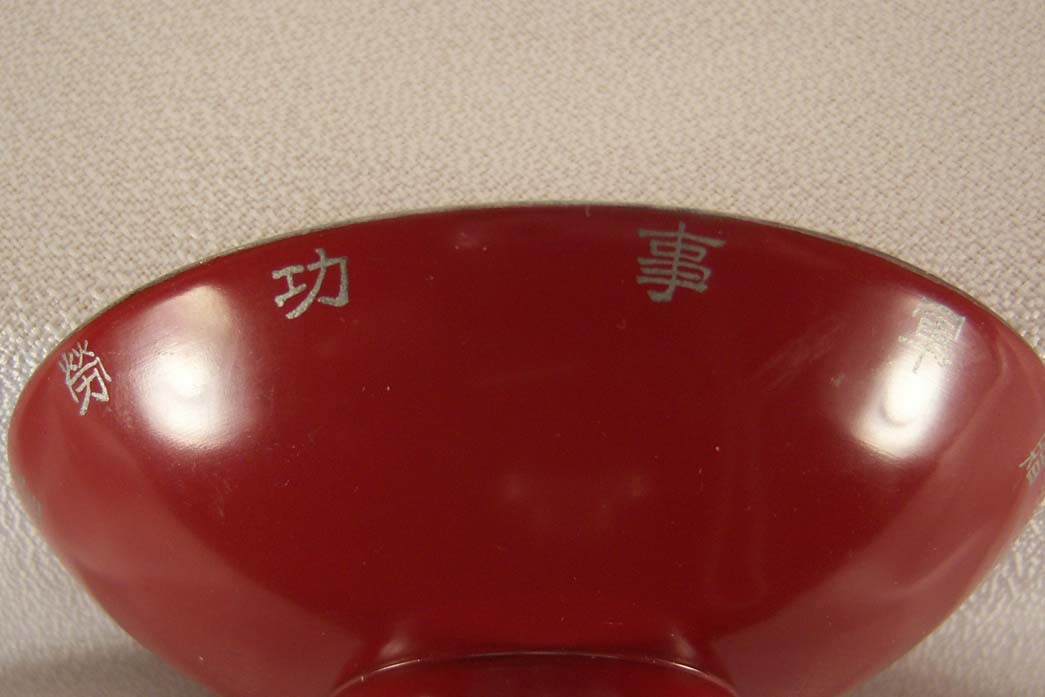
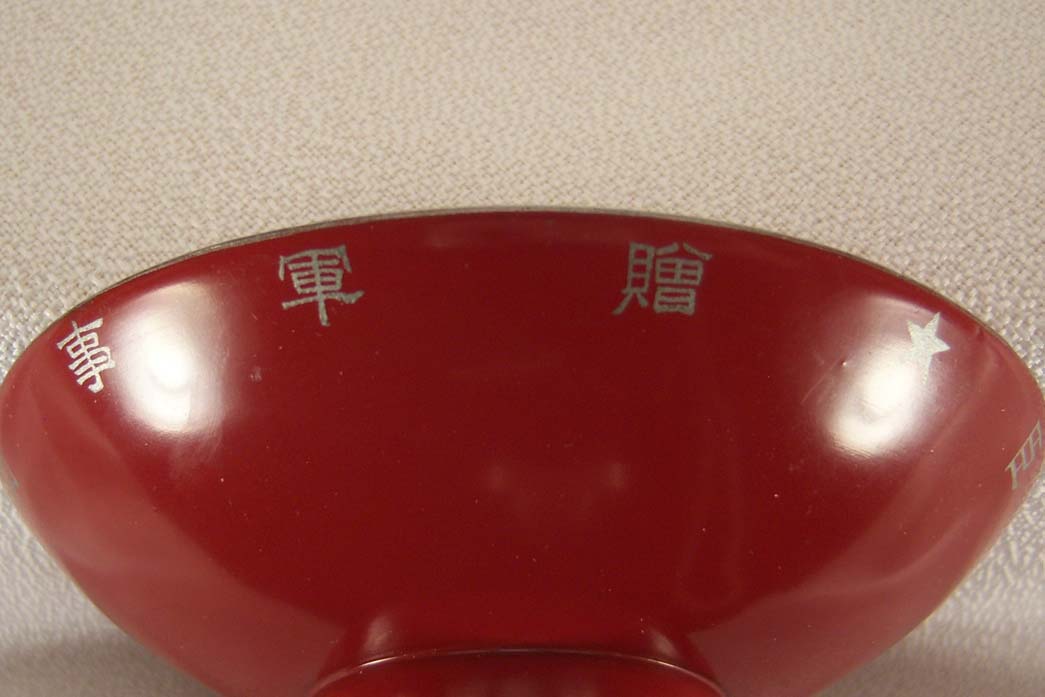
Regards
Brian
0 -
Hello again,
Here is a bowl and sake cup that came with the hoard from the weekend. There is no writing on this pair only a scene and the Nation Flag of Japan.
The bowl is 4 3/4 inches in diameter and the sake cup is just under 4 inches in dia. The dealer thought these belonged to the tray but I doubt that very much due to condition if nothing else.
Do you think this is from the WWII era or post war? I really like the scene. If the flag were of the rising sun I would say WWII era but what about the National Flag; I've seen the two together on war era cups,
Thanks again for your help.
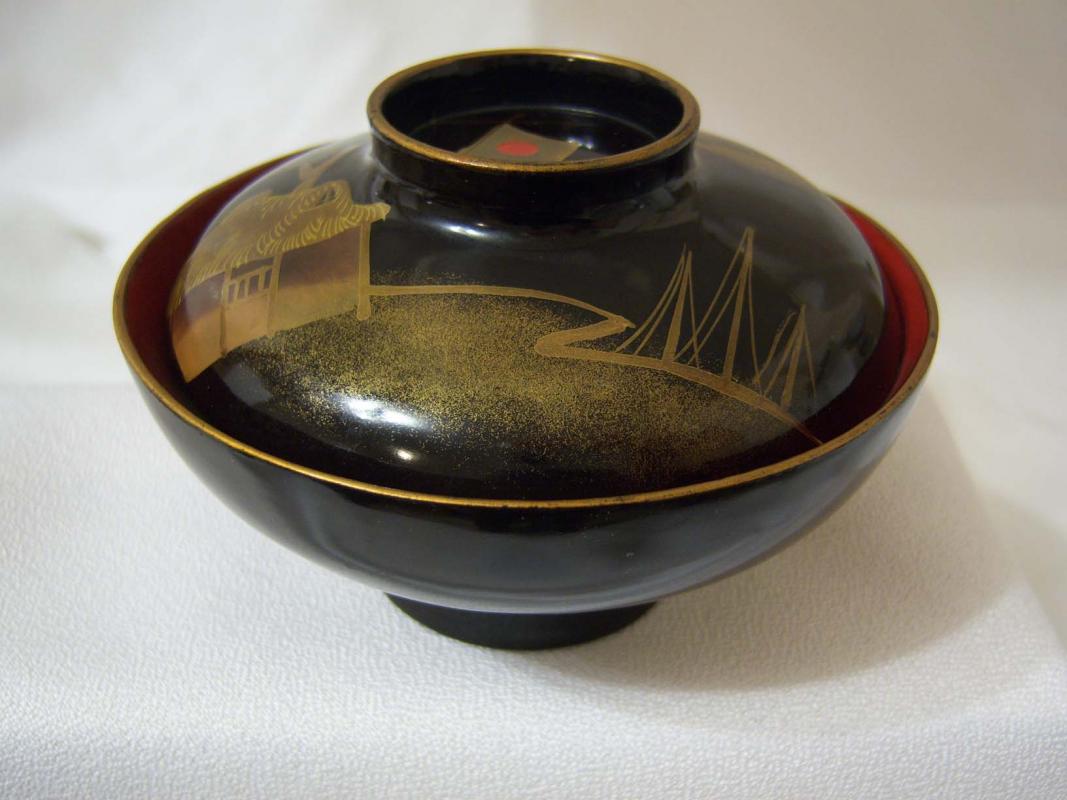
In this photo the distortion is due only to the photography and the shape is actually perfect in "real" life.

This is a photo of the bottom of the sake cup showing the scene and the National Flag of Japan in the centre.
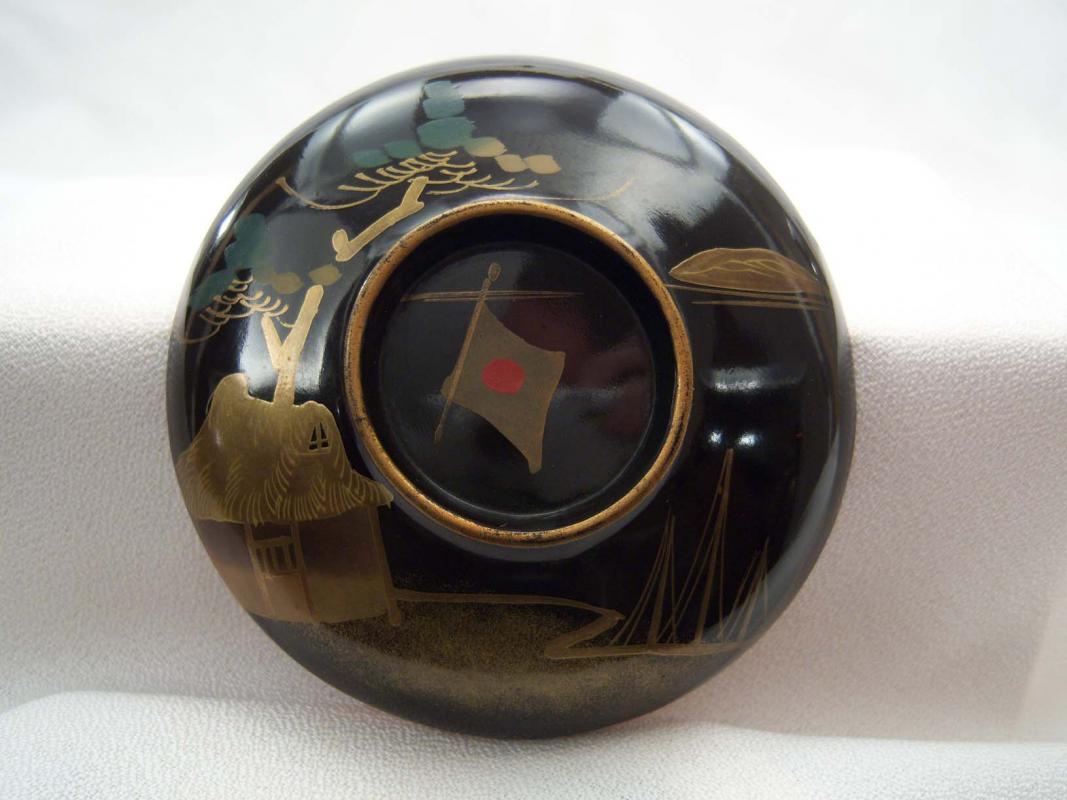
Regards
Brian
0 -
Hello everyone,
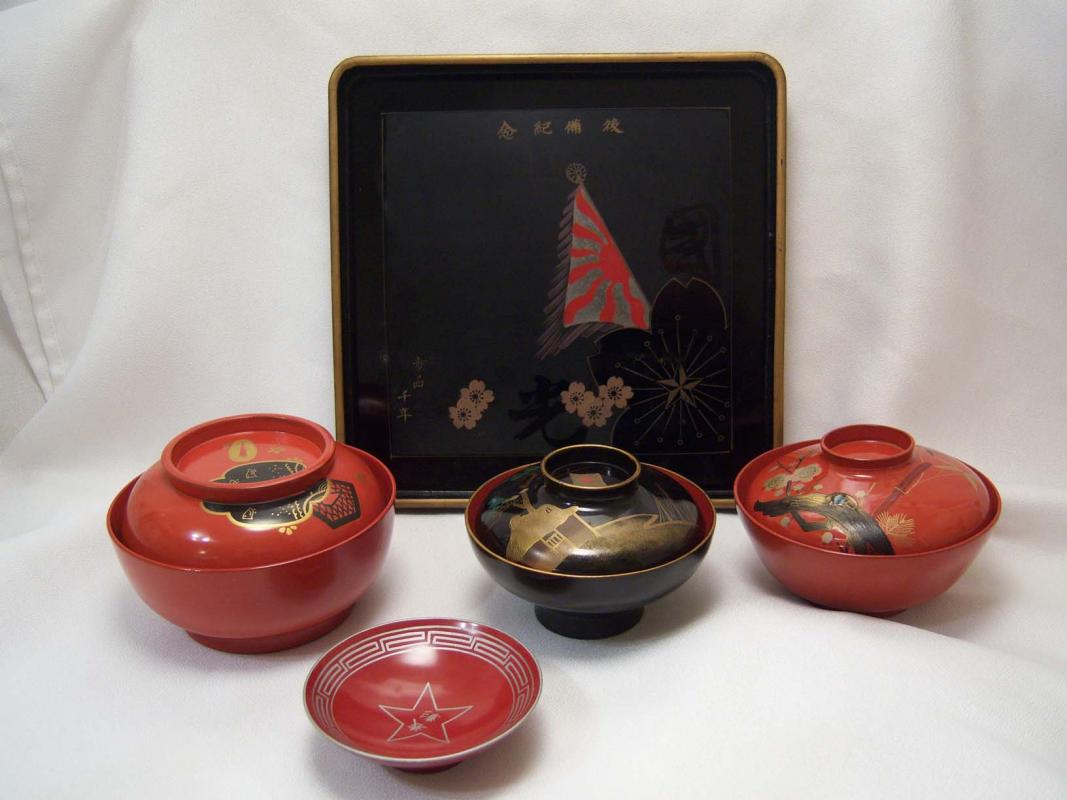
Another item from the lot I purchased on the weekend is the 3 ½ inch sake cup which I need assitance in translating. From the star I am assuming this was an army sake cup.

This is the writing on the insde of the cup. I have read that the writitng on the inside is usually the recipient's name while those found on the bottom is the maker's name.
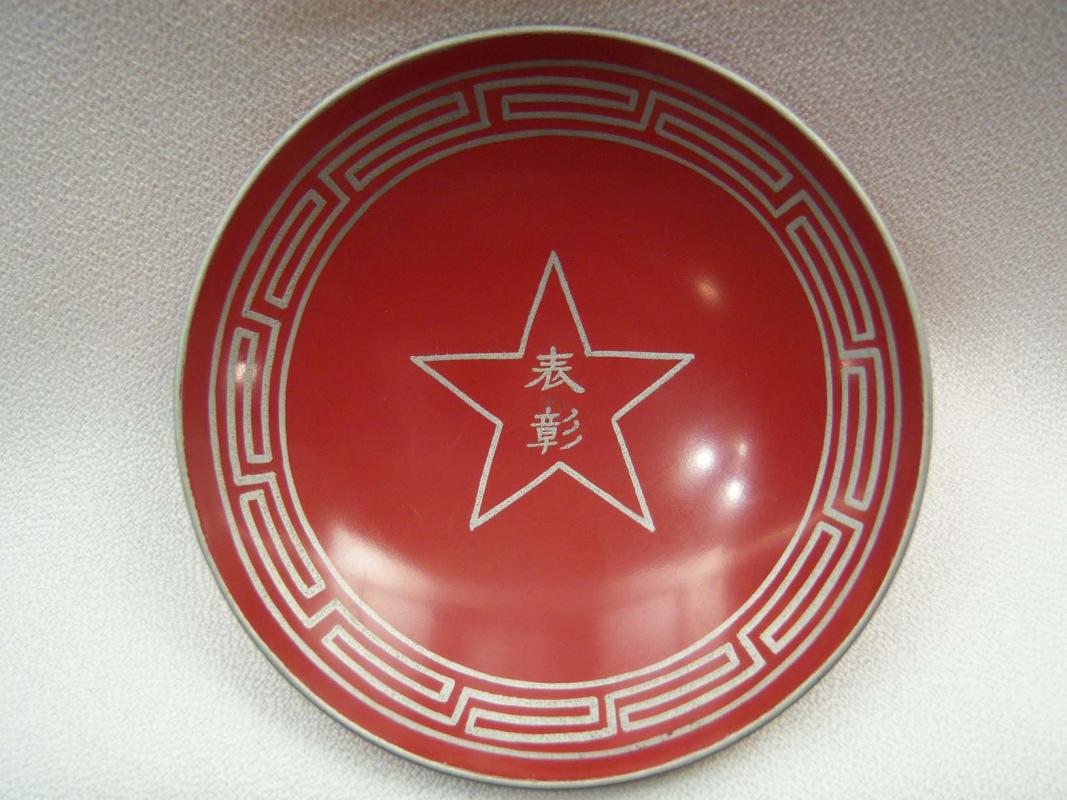
Around the rim is what appears to be two messages separated by stars. I have tried to show each message two kanji at a time.
Here is the first message.
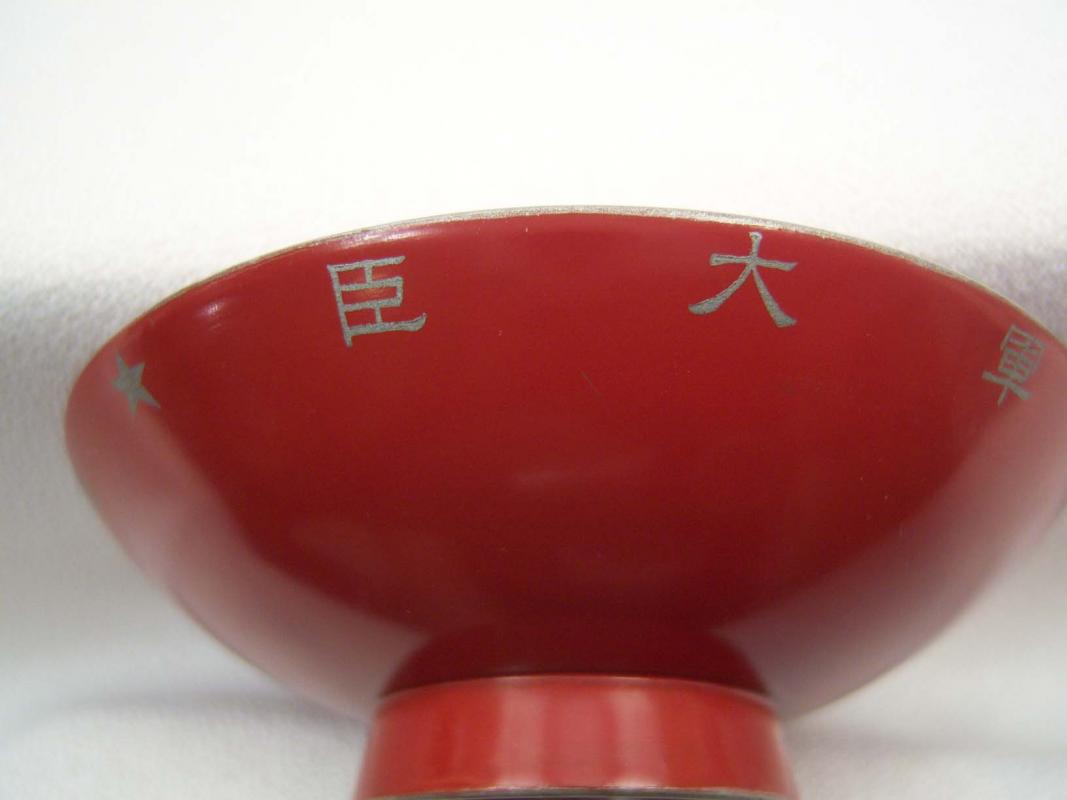
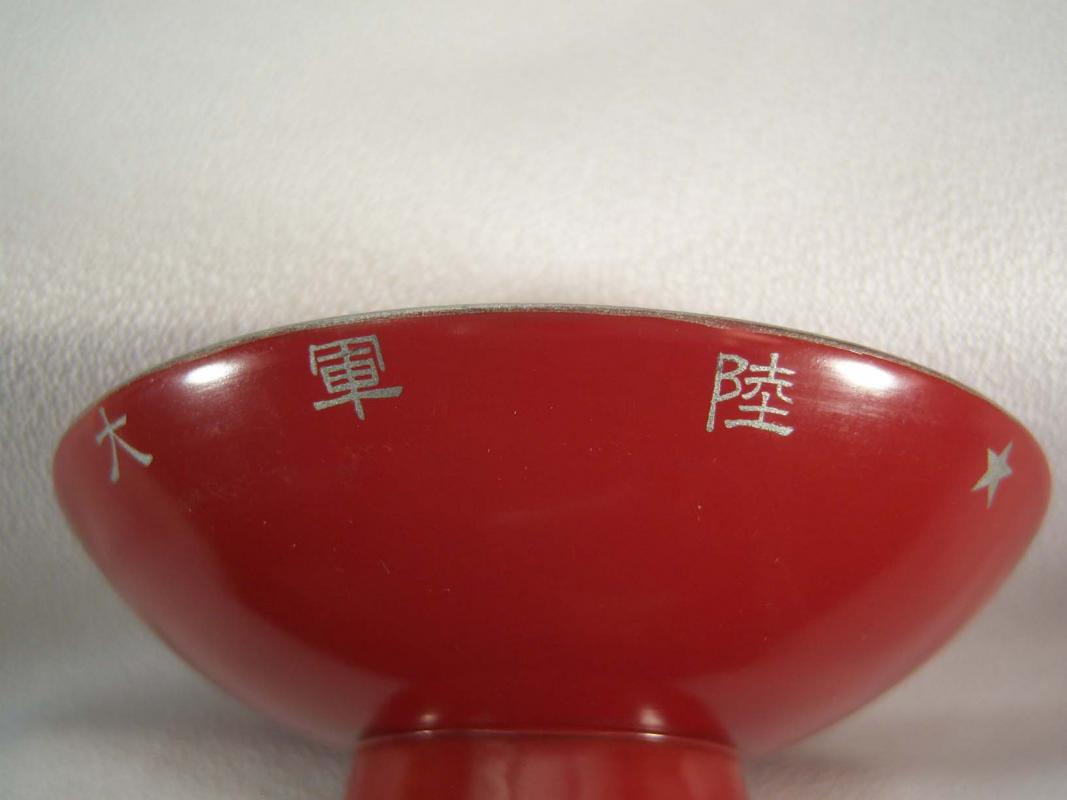
The second message is next.
' alt='' class='ipsImage' width="1000px" height="749px">
' alt='' class='ipsImage' width="1000px" height="749px">
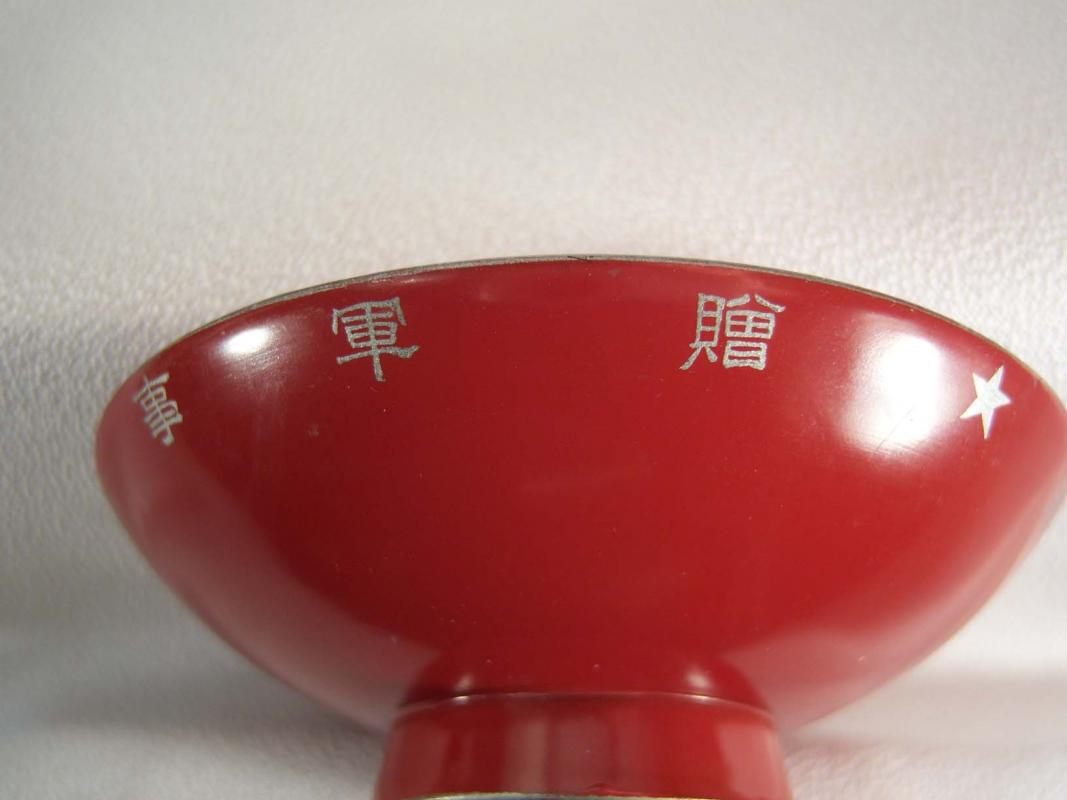
Thank you very much for your help.
Regards
Brian
0 -
Hello Everyone,
While at a gun show on the weekend I noticed a group of Japanese items on a dealer’s table that I’ve noticed there for the past several shows. I never looked at this grouping too closely as his prices were two or three times what they should have been. Each show he seemed to push these items farther to the back edge of his table and there was always something partially covering them; a photo, book or uniform for example. This time I decided to at least look at the pieces more closely. There was a nice lacquered sake cup that was priced below market value that caught my eye. Upon picking up the cup the dealer, seeing my interest, said that he would give me a great deal if I wanted the lot. I asked; he offered; I fainted. Well I didn’t faint but I certainly couldn’t hide my excitement at his price. It was obvious that he had kept these items on his table from show to show long enough and wanted to get some of his money back from them.
I usually purchase my Japanese items, medals, sake cups, merit award etc. from known dealers, some who are members here. This assures me that some if not all of the translations are done for me at the time of purchase. This seller seldom purchased anything such as this so was of no help to me. So I am coming to the membership for assistance with my dilemma. I have gone through the few books I have on the subject and checked out a very good site on the internet, (Rich’s web page; I highly recommend this site to all). In the end I am left no more enlightened than when I started. If you could please give me some assistance it would be greatly appreciated.
I will post each of the five items in a separate post to help avoid confusion (mine) and note in the subject line 1/5, 2/5 and so on.
Thank you in advance for any assistance you can extend to me.
Regards
Brian
The first photo is of the group I purchased. For me a real treasure trove.

In this post I would like to deal with just the Sake Cup Tray.

There are two images of kanji that were made at the same time as the tray and therefore would no doubt (in my mine) be generic to all trays sold by this manufacturer.
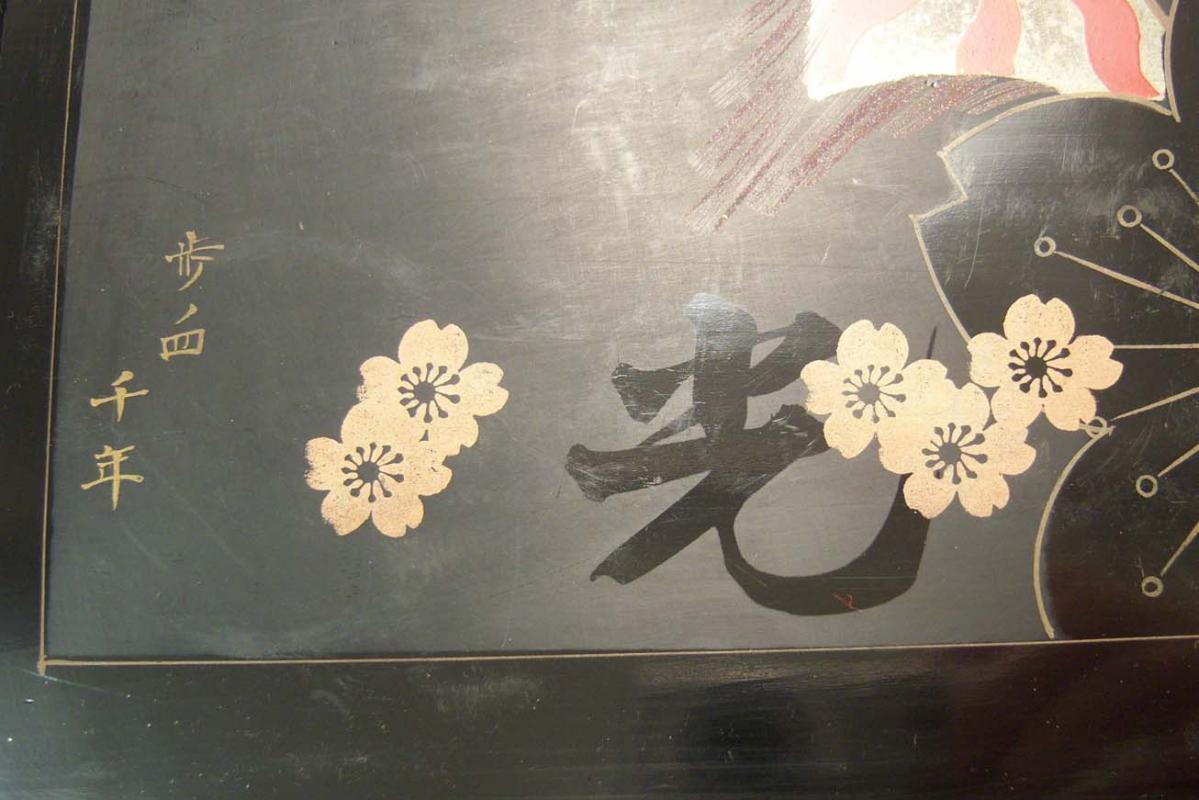
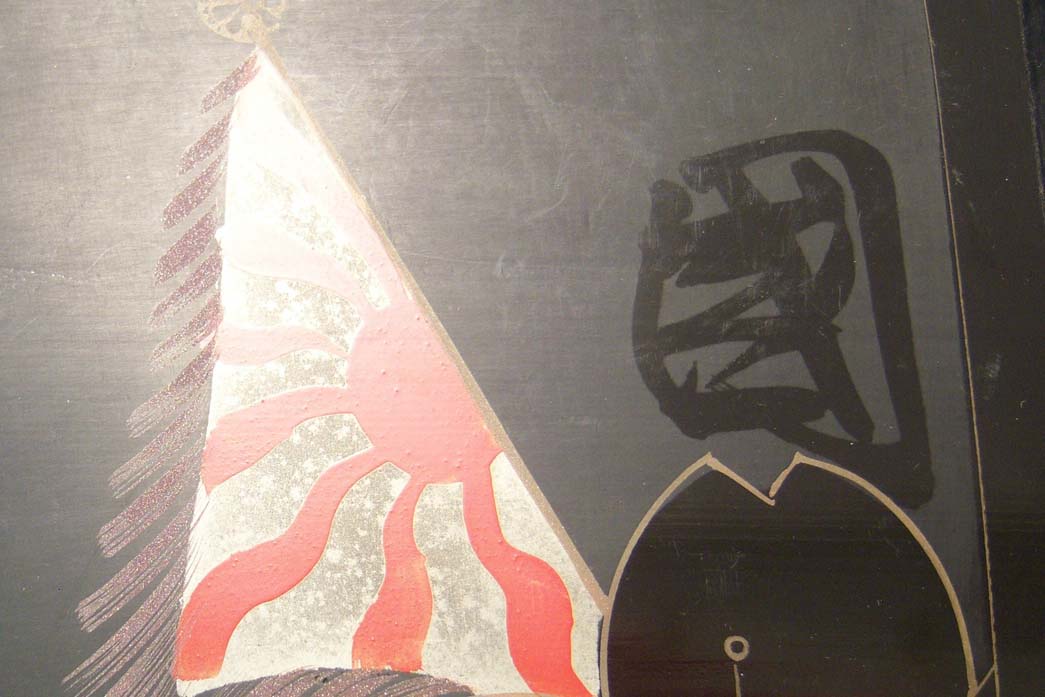
This is a close-up of the next translation I would like help with.
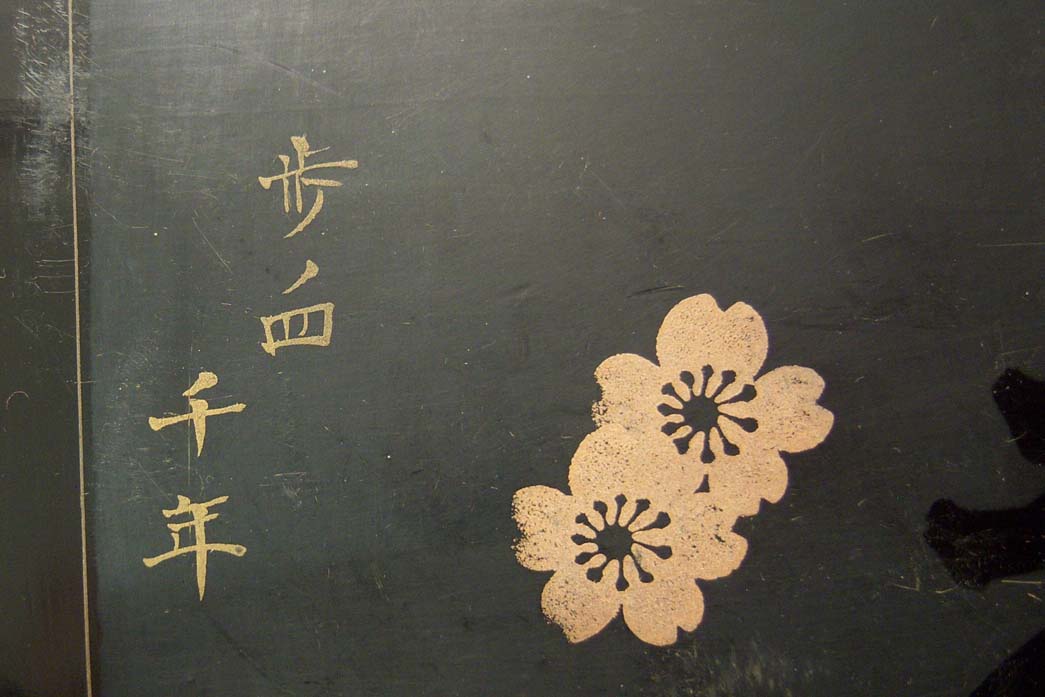
Here is a close-up of the writing at the top of the tray.
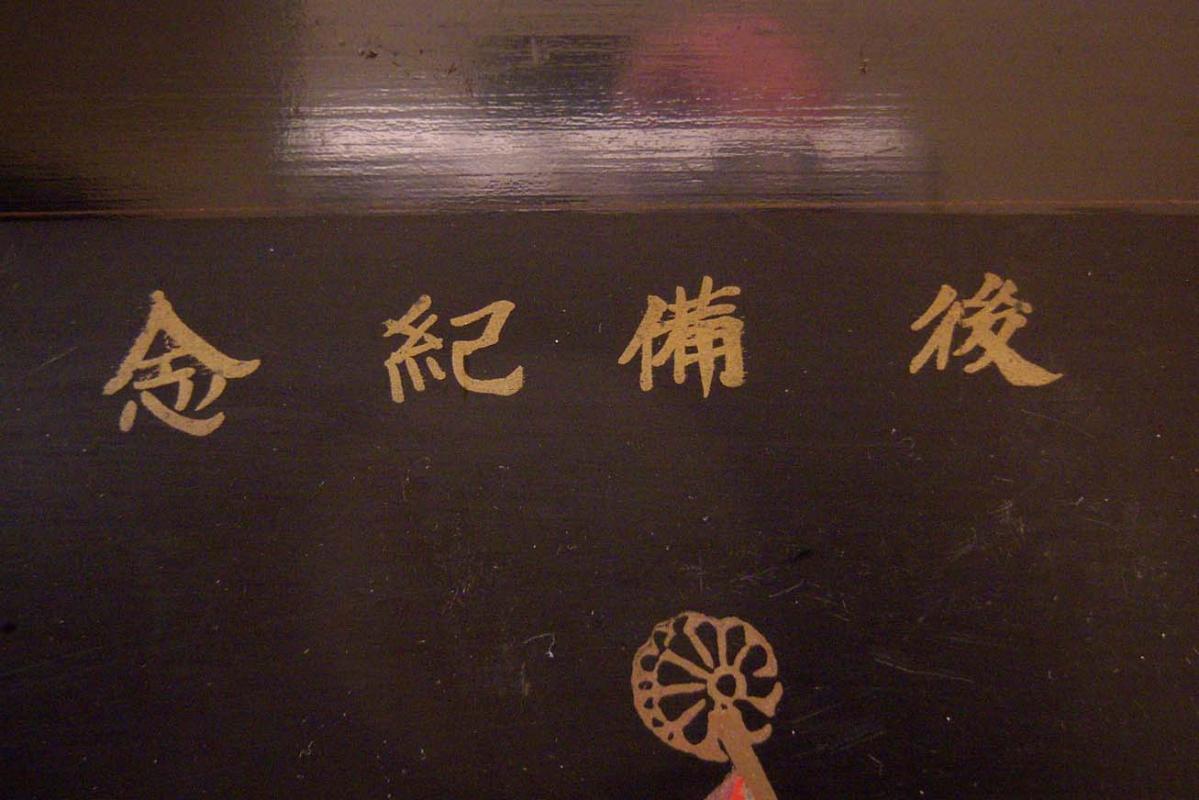
Thanks again for any help you can give me.
Regards
Brian
0 -
Good eye Nick. I'm not sure how many other members have seen this film but I liked it well enough to purchase the DVD. An excellent
film despite the errors in the medals. Still you would have thought that they could have put more attention to getting these details correct.
Thanks for pointing this out.
Regards
Brian
0 -
Hi Stuart,
Good to see you on the forum.
Spelling? I messed up your first name but have now edited the error.
Welcome back.
Regards
Brian
0 -
I do wonder if this is a case where the helmet was "refitted" in order to use as a stage prop or as a cheaper alternative to an authentic piece used as a decorator item. It is frustrating when these reach an auction house and are released onto the collector market.
Well done pjak and Stuart.
Regards
Brian
0 -
Thanks Nick.
Regards
Brian
0 -
Hello Everyone,
I thought that members interested in armour and especially Japanese Armour, as I am, might find this article from our local paper, The Waterloo Region Record, interesting. If by our good luck any members might just be in the area where this is being displayed it would be great if some photos could find their way back here to the forum.

Regards
Brian
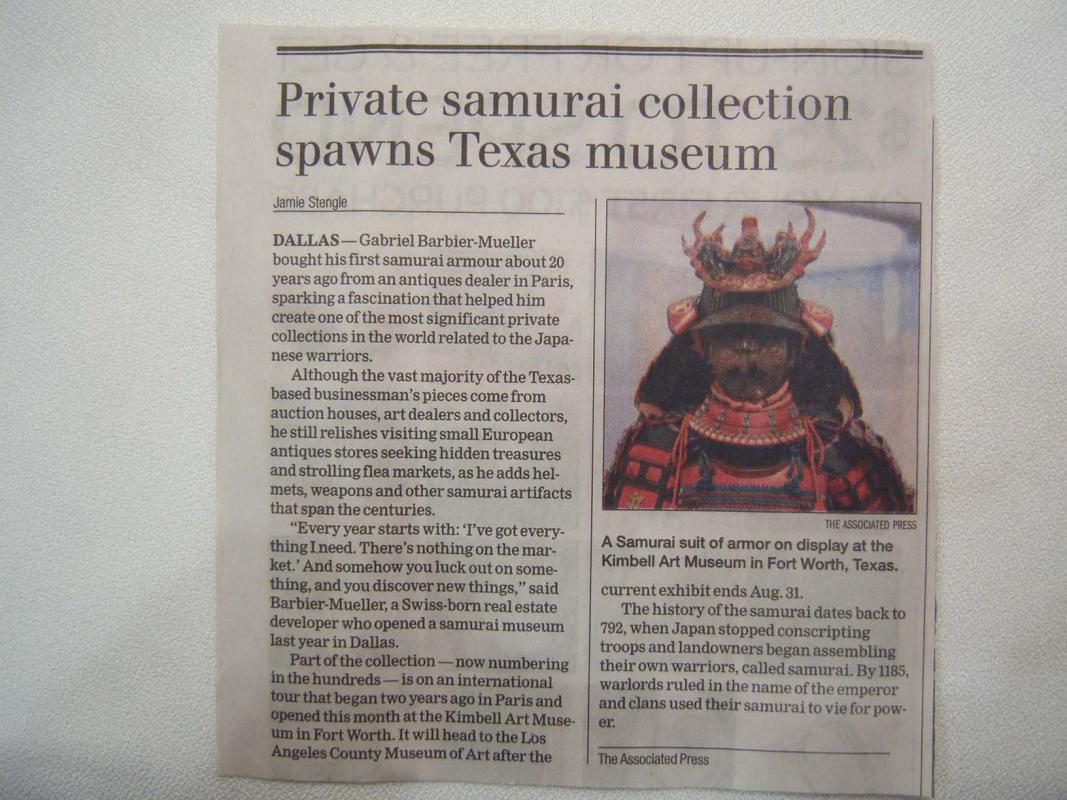 0
0 -
Hello Everyone,
I've always had an interest in Japanese armour and I thought that since we are all interested in Japanese items in this section that I would post it for your interest.
It's not that significant an article so I am "pinning" it so that it can be more easily found and removed later. I'd rather not keep a lot of trivial articles in this section if it can be avoided.
Regards
Brian
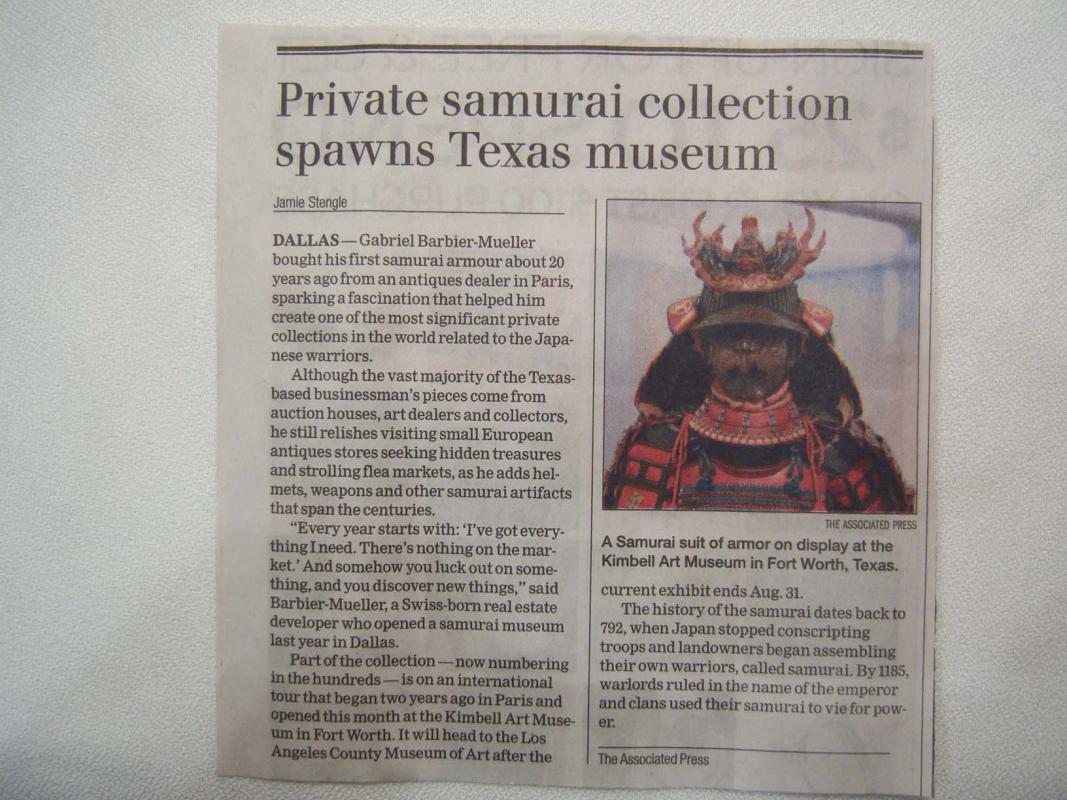 0
0 -
This is the first time I have heard of these and I would recommend anyone to view the whole video.
Thank you very much for posting this Taz.
Regards
Brian
0 -
Hello Harry,
An amazing post filled with seldom seem images of, as Mervyn said, an almost forgotten part of the War.
Thank you for posting this.
Regards
Brian
0 -
Hello Hugh,
Thanks for your comments. I would be more than happy if both sides had issues with some points, that way I would feel that I have remained as neutral as possible.
I've read many accounts of these conflicts by authors from both sides and about the only thing they seem to agree on is that there were indeed conflicts. If I have fallen prey to propaganda from either side then I apologize as there was no intention to show preference.
Regards
Brian
0 -
Pakistan’s General Service Medal
Throughout the history of modern warfare most countries have awarded medals to their military personnel for service during times of war. In the past, major wars were often defined by one decisive battle. At times that final battle defined the whole war, as in the Battle of Waterloo, for which the British, among others, struck a medal.
In time, as conflicts became shorter and more isolated to specific brief campaigns and/or punitive raids, there was still a need to recognize the service by the military. The striking of a separate medal for each small conflict would have been too expensive and the resulting massive groups of these campaign medals being too heavy to even wear on a uniform. The answer was to issue a General Service Medal and affix bars or clasps to the ribbon for each campaign. Most countries have implemented a general service medal and Pakistan is no exception. The general service medal of Pakistan is called the,
Tamgha-i-Difaa

In the photo below we see the obverse and the reverse.
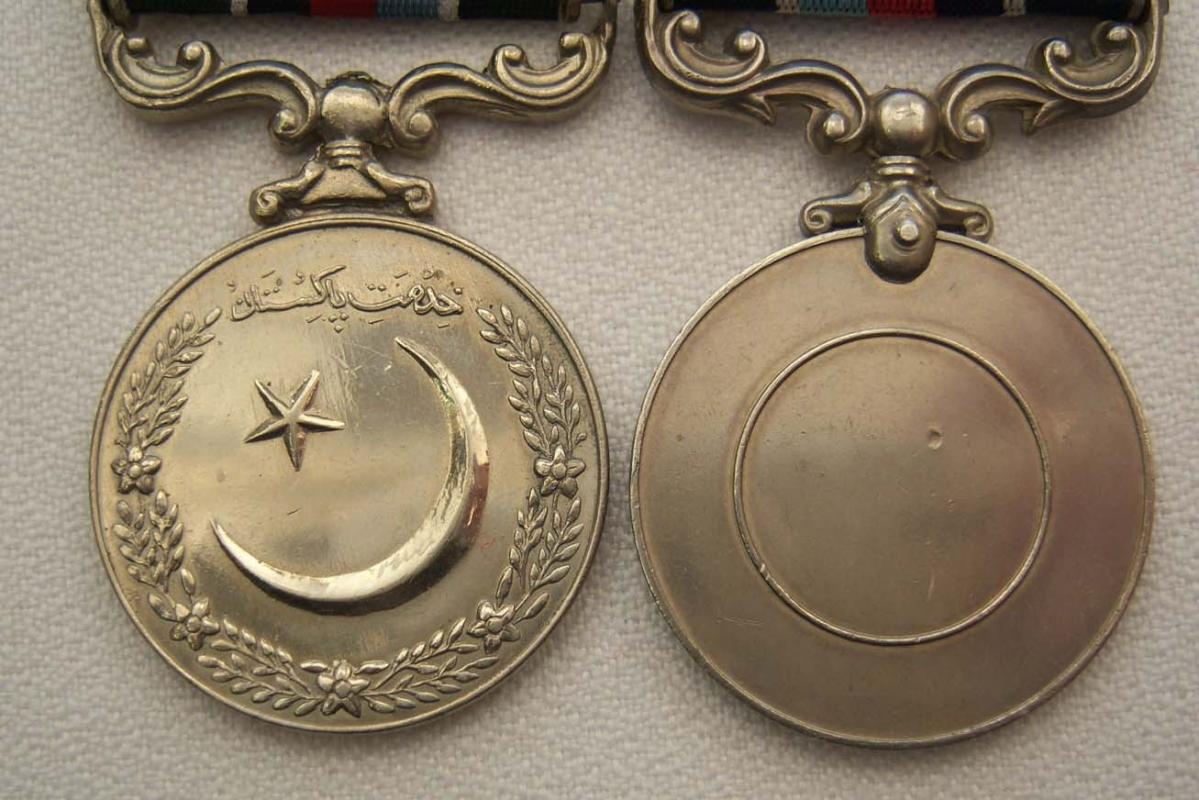
The Clasps
As we look at the different clasps (or bars if you prefer) please note that I have tended to stay away from the usual list of casualties and loss of material and focused more on the individual conflict itself along with a brief overview of the actions. I have also attempted to temper the view of the conflicts, resulting in these clasps, to as much of a neutral attitude as possible rather than attempting to weigh the views of both sides (Pakistan and India) and then draw an uneducated conclusion; knowing full well the difficulty of either side to remain completely objective and unbiased.
Kashmir 1948
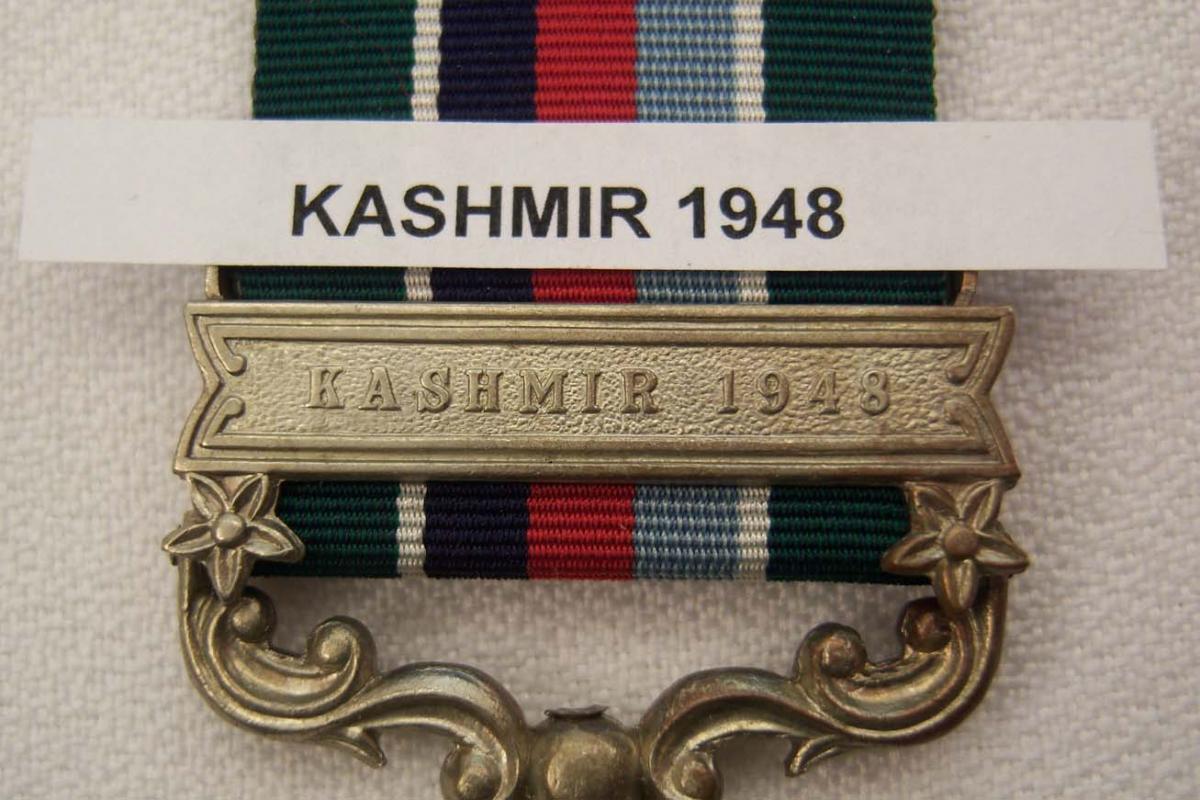
This clasp was awarded for service during the Indo-Pakistani War of 1947-48, also known as the First Kashmir War, which was fought over and in the Princely State of Kashmir and Jammu. Muslim tribal militias backed by the Pakistani Army crossed the border claiming it to be needed to quell a rebellion in the Princely State. Originally this was a conflict between the Princely State and the Muslim Militias, however as Pakistan took an ever greater part in the action the Hindu ruler, Hari Singh, fearing a Muslim uprising, requested assistance from India. In return he agreed to join the Union of India. After several engagements between India and Pakistan the Indian Prime Minister, Jawaharlal Nehru, requested the UN to intervene and a cease fire was arranged in December of 1948. The war resulted in India claiming the bulk of the area which included the regions which were best suited to agriculture and also containing the largest percentage of the population.
Dir Bajaur 1960-62
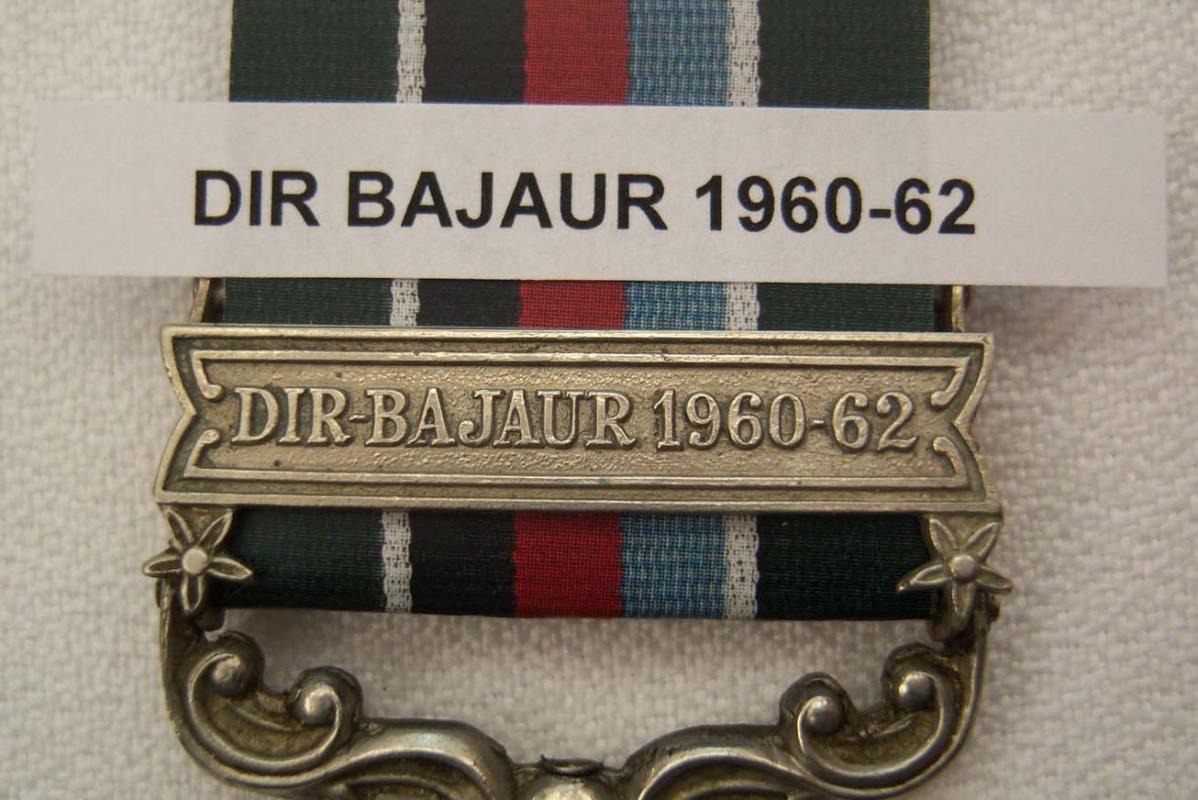
After the creation of Pakistan in 1947 several small areas near the Afghanistan border such as Bajaur and Princely States such as Dir remained independent though with agreements which loosely tied them to Pakistan. Shortly after these agreements were signed armed insurgents funded by Afghanistan started to infiltrate these areas. The goal of these tactics was to drive the areas, in this case, Dir and Bajaur, to seek assistance from Afghanistan and thereby secure the areas under Afghanistan’s rule. For several months the forces of these small independent states resisted the insurgents which tried the patience of the Afghanistan government causing them to send in their regular army. This in turn caused the ruler of Bajaur, the Nawab of Khar, to request assistance from the Pakistani Army. The Afghani Army was forced to retreat and the Pakistani military built forts along the border and made a commitment to station troops permanently in Dir and Bajaur, along with the other areas and states along the border. This whole area is now under Pakistan’s Federally Administered Tribal Areas (FATA) agency.
Rann of Kutch 1965
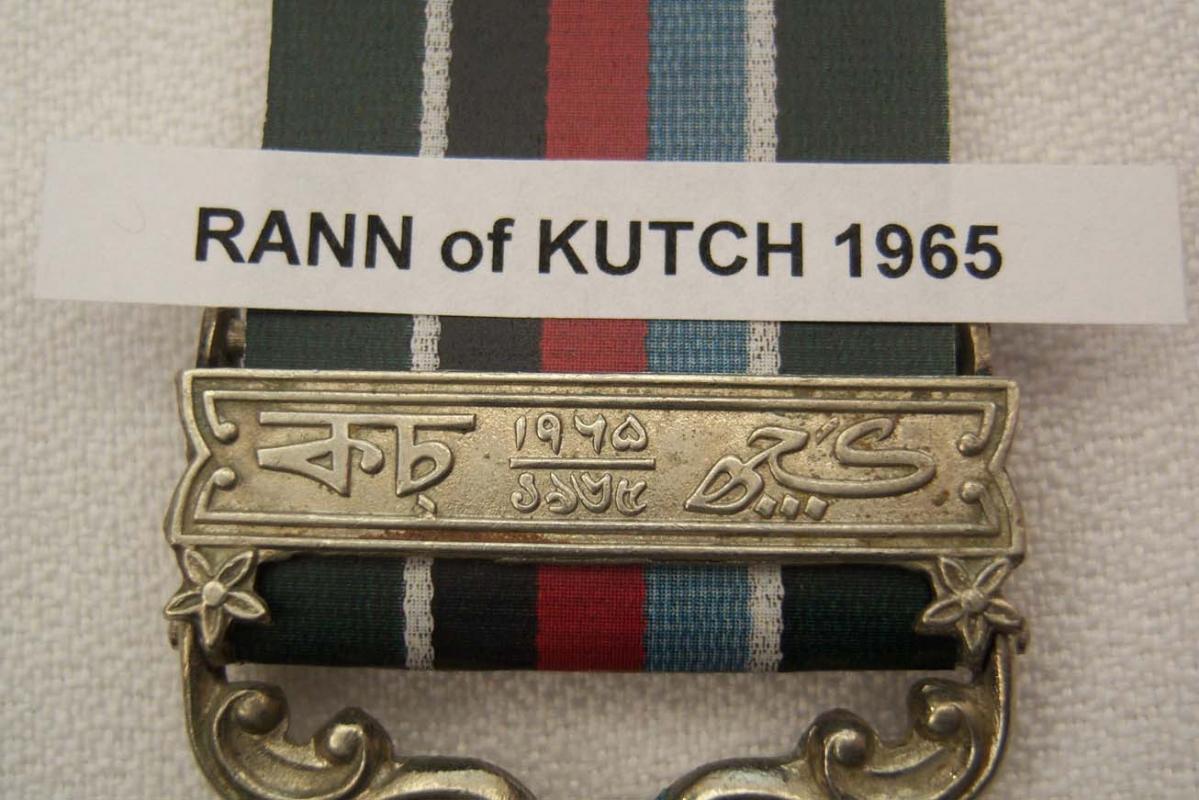
The Rann of Kutch is an area along the border between Pakistan and India in the Indian State of Gujarat. Rann itself is a low area on the Arabian Sea coast and alternates between a salt flat and a tidal basin. This disputed area was part of the border negotiations and in 1960 it was agreed that since there had been no agreement reached that the area would be left as it was until future discussions and a resolution could be reached.
In 1965 Pakistan moved American supplied tanks into the area, under protest from the United States; the protests were, of course, ignored. The reasons for this move on the part of Pakistan was to test the American resolve that armour supplied to Pakistan would not be used to attack Indian territory. A more tactical reason for this decision was to attract Indian forces from the North and away from Kashmir where attacks had been planned by Pakistan in the near future. India first noticed increased Pakistani Border Police patrols probing deeper and deeper into India and followed by the establishment of a line of forts, again well within India territory. Pakistan was very confident in their actions based on what they viewed as a demoralising defeat of Indian forces by China in 1962 which would make India reluctant to engage in another war anytime soon. The Indians were not about to suffer another humiliating defeat and counter-attacked. In the end of this five month long war (April to August) a tribunal of the UN was requested by both parties and a settlement reached. The small gains by Pakistan, of Indian territories, gave them confidence that they could defeat India in a full scale war. This would prove to be a huge misinterpretation of the Indian resolve as will be seen next.
Kashmir 1964-65
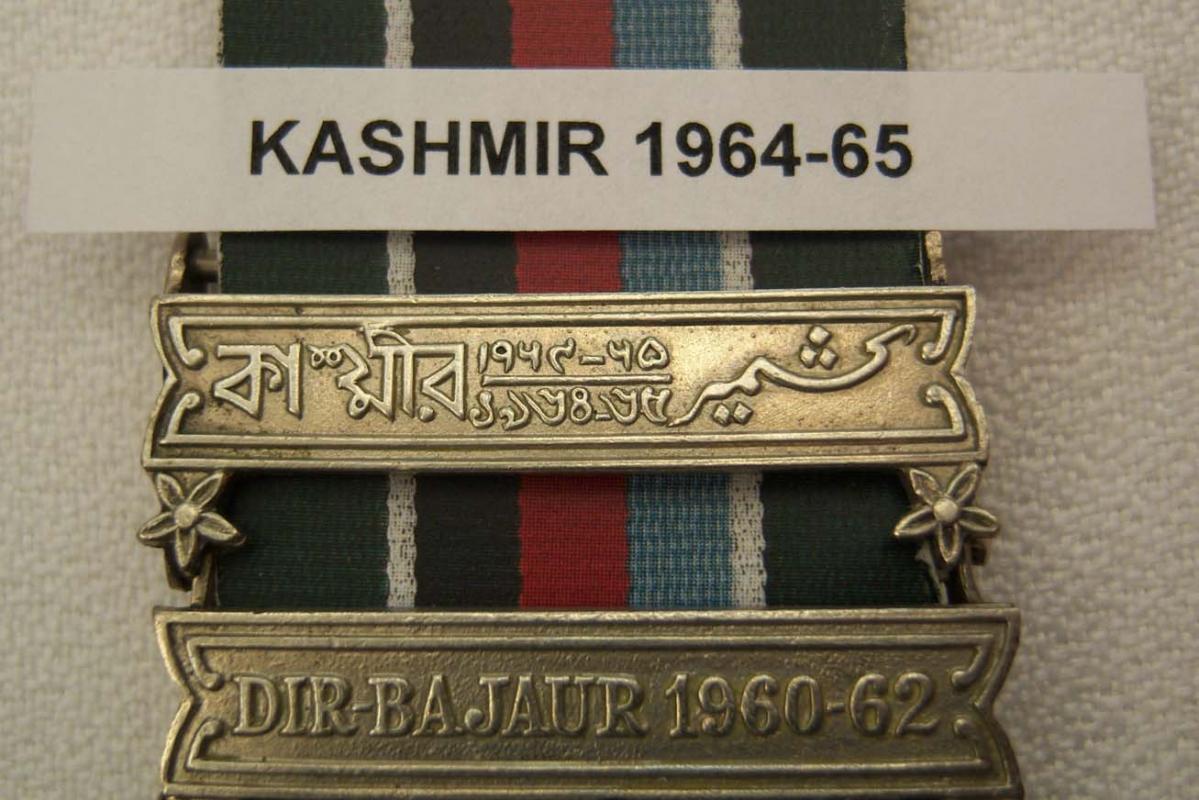
Pakistan and India were once again to see conflict in Kashmir in1965 for what would become to be known as the Second Kashmir War. The war itself was the end result of several border skirmishes and was, for the most part, carried on along the border of the two countries. The UN stepped in after five months of intense fighting mandating a ceasefire between the two countries.
As in 1948 (First Kashmir War) it was an issue of control of the area of Jammu and Kashmir this time with thousands of Pakistani soldiers, dressed as local inhabitants, infiltrating the area. The local inhabitants, rather than siding with the Pakistanis alerted the Indian government to what was taking place and India responded by crossing into Kashmir to engage the enemy. After a back and forth slogging match, escalating from infantry engagements to armour then air strikes, India decided to try a different tactic as both sides seemed to be caught up in a never-ending conflict. This tactic was to open up another front in the Pakistani Punjab. The resulting second front drew Pakistani forces away from the first front in Kashmir to engage the enemy on this new front; resulting in a slight relief of the pressure on Indian forces in Kashmir. Even with the new front and the relocation of some Pakistani forces to the Punjab the war itself was still in a state of virtual stalemate. In the end India held more of Pakistan’s territory (about 700 square miles) than Pakistan did of Indian territory (approximately 200 sq. miles). In a further reflection of the 1948 War India held the more agriculturally significant land while Pakistan gained mostly desert areas.
This conflict is an interesting study in what can take place when miscalculation, false assumptions and lack of intelligence gathering takes place. The Pakistanis believed that the indigenous population, being predominately Islamic would support any insurgence by Muslim Pakistan. This turned out to be a huge miscalculation based on pure speculation. India in turn failed to monitor the area that had proven to be a sore spot between the two nations for years and thereby allowed the infiltration of thousands of Pakistani soldiers. Pakistani military leaders were over confident in the misconception that India would be defeated in a rapid single strike. Perhaps this may have actually worked, however they were discovered before any such action could take place. In addition to this Pakistan did not consider that Indian military planners would open a second front and their lack of foresight and under-estimation of India’s military minds caused the withdrawal of the much needed men and material from the Kashmir front to strengthen the new front in the Punjab.
Perhaps in defence of Pakistan it should be noted that there appeared to be an air of caution on the part of Pakistan that this should not escalate into a full blown war between the two nations. It is speculative to suggest that this fear of escalation may have played a part, no matter how small, in Pakistan’s political and military leaders not pressing the engagements harder than they did. This last paragraph is offered only as speculation and the reader is encouraged to research deeper into the Kashmir Wars to draw their own conclusions.
Siachen Glacier 1984 (to present)
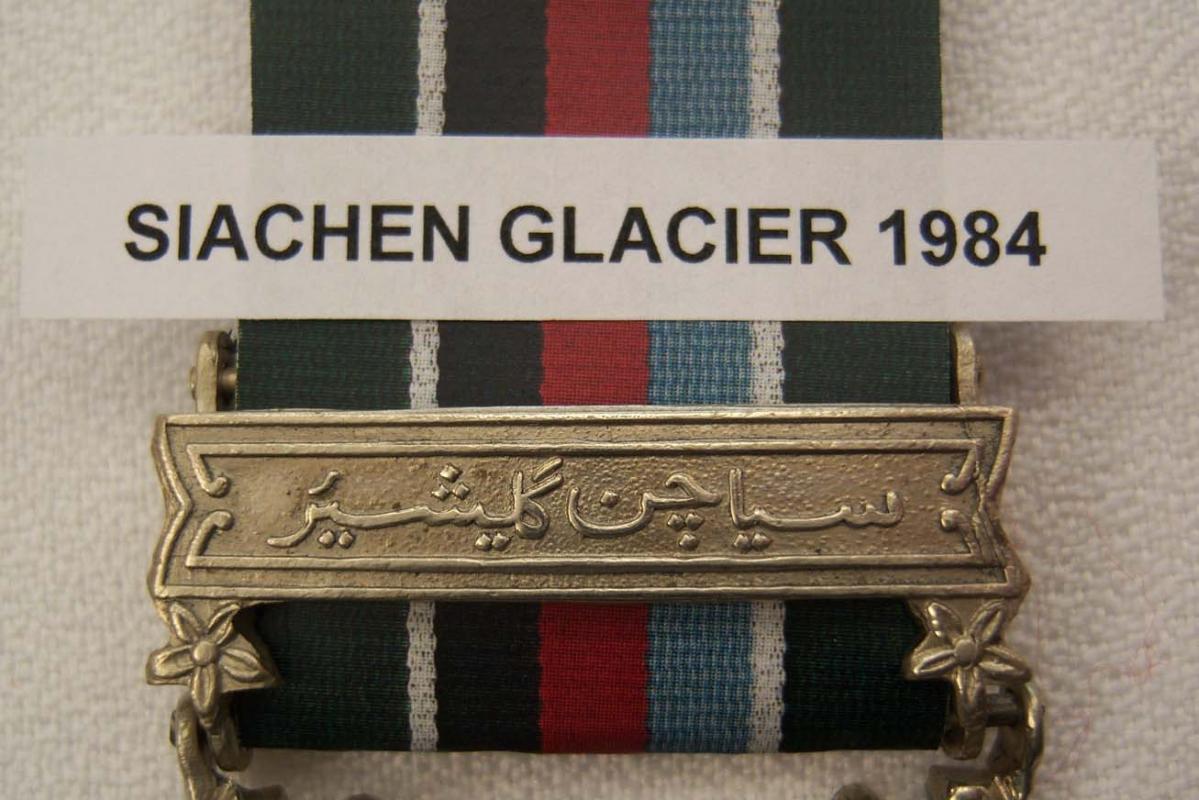
The Siachen Glacier area lies in Northern India and borders India, Pakistan and China. India and Pakistan both claim sovereignty over the region and this resulted in India in1984 launching a large military operation that resulted in their gaining control of this area ever since. Since 1984 there have been many skirmishes between Pakistani and Indian forces but, as yet, no major battles or war.
This area is perhaps the most inhospitable on the planet to attempt to carry out military operations. With both countries maintaining a permanent military presence there have been more casualties caused by the harsh conditions than from enemy engagements. This is due to the Siachen Glacier area being 20,000 feet above sea level. Interestingly enough both sides would like to withdraw from the area and plans were under way by India to do so. However due to Pakistani incursions during the 1999 Kargil War [see below] these plans were terminated. This leaves the Siachen Glacier the highest altitude in the world where an ongoing military stand-off is taking place. Access is so difficult that, other than helicopters, both sides still find themselves relying on mule transport. Indian medals can be found with the recipient’s regiment given as, ASC AT (Army Service Corps, Animal Transport).
[ 1999 Kargil War: Fought between India and Pakistan from May to July, 1999, once again in an area of Kashmir. Pakistan withdrew as part of an agreement that the United States would mediate the dispute. India remains in control of the area].
I hope you found this article on Pakistan’s General Service Medal the Tamgha-i-Difaa, its clasps and their brief history interesting.
Regards
Brian
0 -
A very attractive display mount Chris.
Regards
Brian
0




British Regiment Memorials around Kohima, Nagaland, India ** REGIONAL ADMIN. AWARD & CERTIFICATE OF MERIT.
in Great Britain: Research, Documentation & History
Posted
Hello Harry,
The change has been made.
Regards
Brian